For many men, stubborn abdominal skin and fat pockets can linger despite a disciplined diet and exercise. A sizable weight loss adds to the likelihood of excess skin and the need for potential muscle repair.
A male tummy tuck, technically known as abdominoplasty, is a surgical procedure that removes excess skin and fat, often tightening the underlying abdominal muscles. This targeted approach not only flattens and firms the midsection but also enhances masculine contour. Results that simply can’t be achieved through exercise alone.

At Moein Surgical Arts in Los Angeles, Dr. Babak Moein leverages two decades of expertise in cosmetic and weight-related surgery to deliver natural-looking, athletic outcomes. Our specialized male abdominoplasty techniques focus on minimal scarring, precise muscle repair, and tailored contouring to ensure you look and feel your best.
[joli-toc]
What Is a Male Tummy Tuck and How Does It Differ for Men?
A tummy tuck removes excess tissue and tightens muscles, but in men, the procedure often includes unique refinements, like abdominal etching, to accentuate the V-shape taper from ribs to hips. Key types include:
⦁ Mini Tummy Tuck: Targets lower abdominal skin laxity
⦁ Standard (Full) Tummy Tuck: Addresses both upper and lower abdomen
⦁ Extended Tummy Tuck: Includes flanks for a more comprehensive contour
⦁ Circumferential (Lower Body Lift): Wraps around hips and back
Abdominoplasty for men goes beyond simple fat removal. Because male fat distribution and muscle structure differ from women’s, surgeons employ techniques, such as plication of the rectus muscles and strategic liposuction, to enhance definition and maintain a naturally masculine silhouette.
Moreover, male skin tends to be thicker and more fibrous, requiring careful handling to prevent irregularities and ensure smooth, even results. By understanding these differences, your surgeon can customize the procedure for a strong, athletic midsection.
Benefits of a Male Tummy Tuck
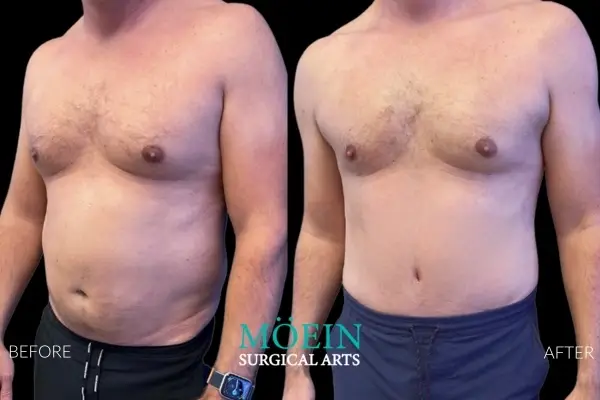
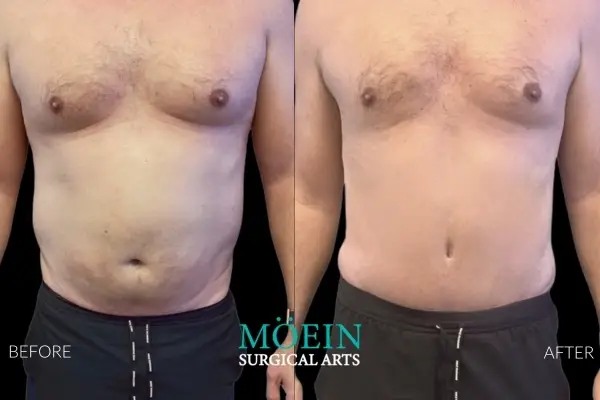
A male tummy tuck delivers both aesthetic and functional improvements:
⦁ Tighten Loose Skin: Eliminate sagging and wrinkling post–weight loss
⦁ Remove Stubborn Fat: Directly extract fat cells that resist diet and exercise
⦁ Repair Weakened Muscles: Reconnect and tighten separated rectus muscles for core strength
⦁ Improve Posture: Correct spinal alignment by removing excess weight off the front of the body
⦁ Enhance Athletic Contour: Achieve a ⦁ defined, six-pack appearance with abdominal etching
⦁ Boost Confidence: Restore comfort in clothing, gym sessions, and social settings
Beyond cosmetic gains, many men report reduced back pain and improved core stability after muscle repair and fat removal. By addressing both form and function, a tummy tuck can transform physical comfort as well as self-image.
Who Is an Ideal Candidate for Male Abdominoplasty?
One of the most asked questions men ask is if they are a good candidate for tummy tuck. You may be a strong candidate if you:
⦁ Maintain a stable weight and healthy lifestyle
⦁ Are in ⦁ good overall health⦁ with no untreated conditions
⦁ Have realistic expectations about outcomes and recovery
⦁ Do not smoke can quit at least 6 weeks before surgery
⦁ Experience loose skin or muscle separation (diastasis recti)
⦁ Struggle with stubborn fat pockets despite diet and exercise
Men who undergo significant weight loss, whether through lifestyle changes or bariatric surgery,often find that excess, hanging skin detracts from their results. A tummy tuck removes this redundant tissue and tightens the abdominal wall, allowing your physique to reflect the effort you’ve invested.
Even if you’re uncertain, a consultation with Dr. Moein will clarify your goals and determine if abdominoplasty, supplemental VASER liposuction, or a combination approach is best for you.
The Male Tummy Tuck Procedure: What to Expect
Preparing for a male tummy tuck involves several straightforward steps: each phase, from your comprehensive consultation and pre-operative assessments to the surgical plan and post-operative support, is designed to optimize your results while ensuring your comfort and safety.
⦁ Consultation & Evaluation: Review medical history, exam of abdominal anatomy, and discussion of goals
⦁ Surgical Plan: Selection of mini, full, extended, or circumferential abdominoplasty
⦁ Anesthesia: Typically, general anesthesia, with options for long-acting local blocks
⦁ Incision & Muscle Repair: Detach and tighten the abdominal muscles (plication)
⦁ Skin & Fat Removal: Excise excess tissue; perform targeted liposuction for smooth contour
⦁ Closure & Drainage: Place drains if needed and close incisions with aesthetic suturing
Each step is designed to minimize complications and optimize healing. Dr. Moein uses microcannulas for needed fat removal and gentle tissue handling to reduce swelling and speed recovery.
Following surgery, patients typically wear a compression garment to support the abdomen and reduce fluid buildup. Our accredited surgical center in Beverly Hills ensures the highest safety standards and comfort throughout your procedure.
Recovery and Aftercare: Getting Back to Your Routine
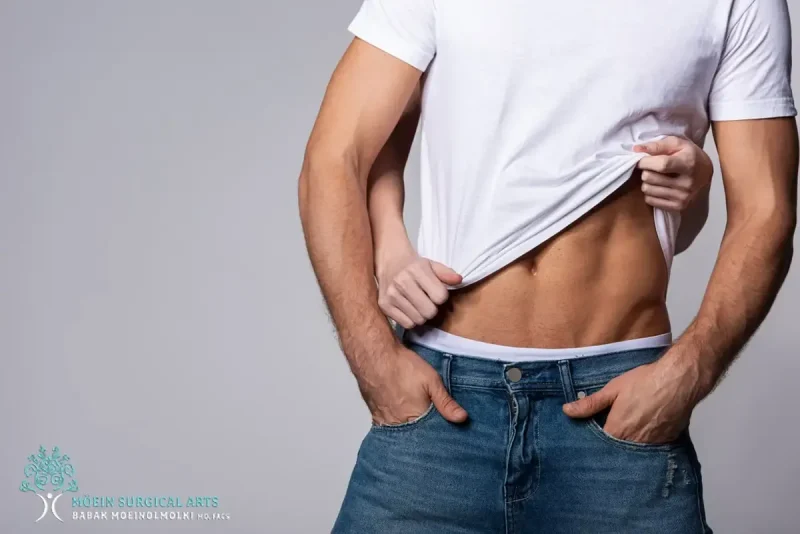
Recovery timelines can vary, but most men experience manageable discomfort that peaks within the first few days—our tailored pain management protocols help keep you comfortable so you can focus on healing. We understand your top concern is returning to work, workouts, and family life as quickly and safely as possible; that’s why our team provides clear milestones and support every step of the way.
⦁ Work Return: 7–10 days for desk jobs; light activity permitted earlier
⦁ Exercise Resumption: Avoid strenuous core workouts for 4–6 weeks; walking is encouraged
⦁ Garment Usage: Wear compression wraps or a binder for 4–6 weeks to control swelling
⦁ Follow-Up Visits: Scheduled at 2 days, 1 week, 1 month, 3 months, 6 months and 1 year
⦁ Scar Care: Apply silicone or topical treatments to promote optimal healing
Initial discomfort managed with prescription medications peaks around day 2–3, then subsides significantly. By 2–4 weeks, most swelling has resolved, revealing a flatter, firmer abdomen. Full maturation of scars and final contour can take up to one year. Patient testimonials often describe the experience as surprisingly manageable, with many returning to daily life almost immediately and feeling more confident with each passing day.
Cost of Male Tummy Tuck in Los Angeles
Understanding investment in your transformation is key: we believe in transparent pricing, so you’ll receive a comprehensive breakdown of all costs from surgeon’s fees and facility charges to anesthesia and post-operative care. This approach ensures you can plan your journey with complete confidence.
LA Area Total Cost: Typically ranges from $10,000 to $18,000 depending on the type of tummy tuck. At Moein Surgical Arts your quote includes surgeon’s fee, anesthesia and facility as well as in-depth consultation, pre and post op appointments for one year.
Variables Impacting Price:
⦁ Surgeon’s expertise and board-certification
⦁ Type of tummy tuck (mini, full with or without plication, extended)
⦁ Geographic location and facility fees
⦁ Addition of liposuction, muscle etching or other procedures
Most health plans do not cover cosmetic abdominoplasty, but financing options are available. Potentially, if you have a hernia repair, part of your surgery may be covered. During your consultation, we’ll review transparent pricing and tailor a plan that aligns with your goals and budget
Why Choose Dr. Babak Moein for Your Male Tummy Tuck?
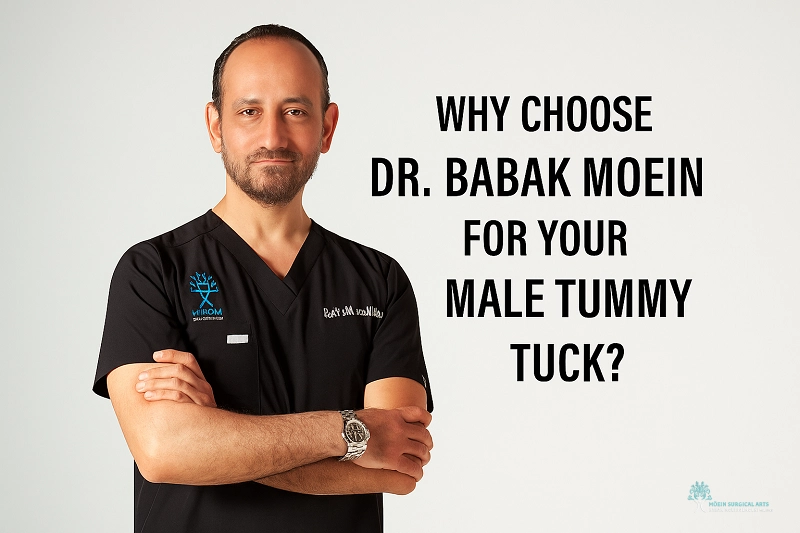
Selecting the right surgeon is the most important step on your journey to a firmer, more defined midsection. Dr. Babak Moein combines decades of specialized training, artistic precision, and a patient-first philosophy to ensure your male tummy tuck delivers natural, athletic contours—and an experience that feels as personal as it does professional.
With every procedure tailored to your unique anatomy and goals, you’ll benefit from world-class safety standards, a hospital-style surgical suite, cutting-edge techniques, and comprehensive support from consultation through recovery. Dr. Moein offers:
⦁ Double Board-Certification: Expertise in both cosmetic and weight-related surgery
⦁ Customized Approach: Procedures designed for masculine anatomy and athletic definition
⦁ Safety First: Accredited surgical center with advanced monitoring and post-op care
⦁ Proven Results: Natural-looking transformations that restore confidence and comfort
⦁ Comprehensive Support: Pre- and post-surgical guidance, from garment fitting to scar management
⦁ Several Financing Options: Moein Surgical Arts has a relationship with several companies that offer financing for a range of credit ratings
Dr. Moein’s commitment to personalized care ensures that every male tummy tuck patient feels heard, respected, and empowered throughout their journey.
Take the Next Step: Schedule Your Consultation
Ready to achieve the flat, firm core you deserve? Not ready to have a “Dad or Mom bod”? Book your private consultation with Dr. Babak Moein at Moein Surgical Arts today.
You can also call once of our appointment coordinators M-F 8 am to 8 pm | Saturday and Sunday from 10 am to 3 pm. We offer a few complimentary virtual appointments each week. Reserve yours today at 301-455-8020.
Discover how a male tummy tuck can unlock greater confidence, improved posture, and a physique that matches your hard-earned dedication.
]]>Diastasis Recti may sound like a complex medical term, but in simple words, it means your abdominal muscles have separated. These are the same muscles that form the “six-pack”, the rectus abdominis. Usually, they’re held together by a strong band of tissue called the linea alba. But sometimes, that band stretches and pulls apart, leaving a visible bulge or gap in your belly.
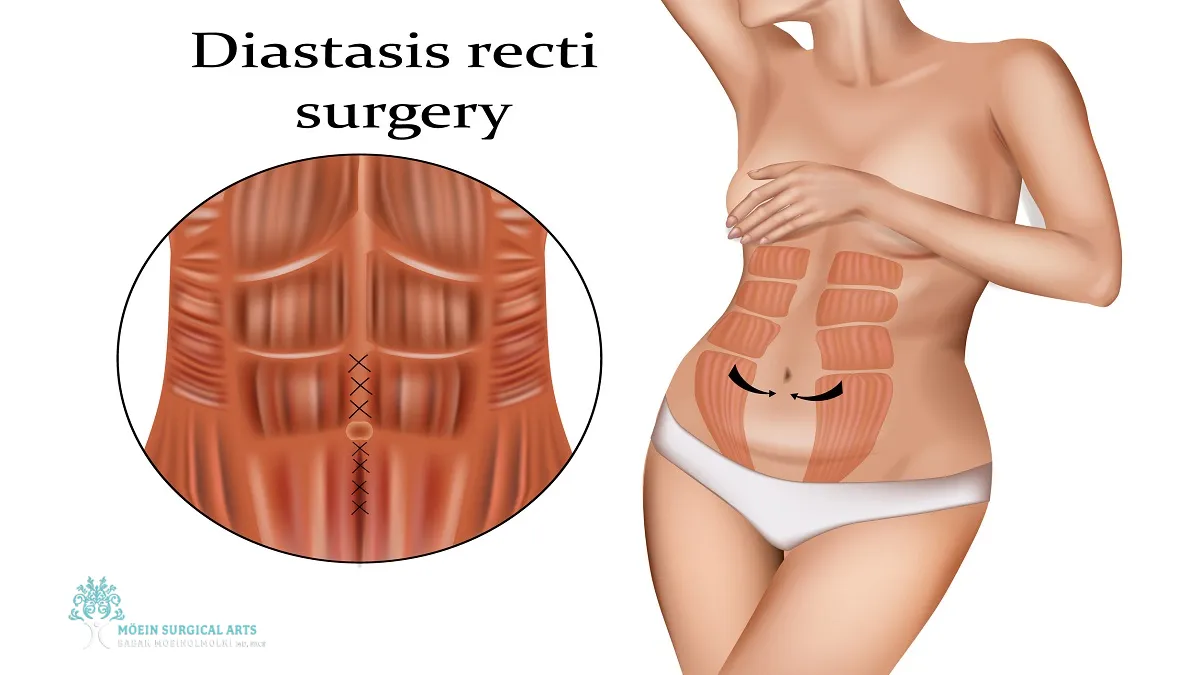
Table of Contents
Definition & Causes of Diastasis Recti
Diastasis Recti is a separation of the abdominal muscles along the midline. It’s not a tear, but a thinning and widening of the connective tissue. This condition is especially common in:
- Women during and after pregnancy
- Men who’ve gained significant abdominal weight
- People who lift weights improperly
- Anyone with chronic coughing or abdominal pressure
- Older adults, as collagen weakens with age
Think of it like this:
Your core is a soda can. When the pressure inside gets too high, the sides bulge. Diastasis is similar to a bulge; it’s the result of excessive internal pressure pushing out on weak spots.
Symptoms That Impact Daily Life
Here’s what many people experience:
- A visible bulge or dome shape in the middle of the belly, especially when getting up
- Lower back pain due to poor core support
- Weak abdominal muscles and core instability
- Poor posture
- Trouble lifting or carrying heavy objects
- Occasional bloating or a “pregnant” look, even when you’re not pregnant
Real-life example:
“I had my last child 4 years ago, but I still looked 4 months pregnant. I didn’t know it was a real medical issue until my doctor checked my core. It turned out to be diastasis recti.”
Ignoring it can lead to:
- Chronic back pain
- Pelvic floor dysfunction
- Poor balance and coordination
- Increased risk of hernias
At Moein Surgical Arts, we take this condition seriously. Because your core is your body’s center of strength. If it’s compromised, everything else suffers from mobility to mood.
How to Self-Check at Home For Diastasis Recti
So, you’re noticing a weird bulge in your belly, or maybe your core just feels… off. You’re thinking, “Could this be Diastasis Recti?” Good instinct! Early diagnosis can make a world of difference.
Step-by-step self-check:
- Lie on your back with knees bent and feet flat.
- Place your fingers just above your belly button.
- Lift your head and shoulders slightly (like starting a crunch).
- Feel the midline of your abdomen with your fingertips.
If you feel a gap or soft spot between the muscles, that could be diastasis recti. You might also feel your fingers sink into your belly more than usual. If you can fit two or more fingers in that gap, it’s worth looking into further.
Tests & Imaging for Confirmation

During your consultation, a physical exam usually reveals a lot. But to get precise measurements or check for related issues like hernias, imaging may be needed.
Common tools include:
- Ultrasound: Measures the gap and tissue thickness
- CT scan: Gives a detailed view of muscle positioning
- MRI: Rare, but used in complex or combined abdominal cases
When to See a Specialist:
If your self-check shows a gap, or if you’re dealing with these issues:
- Persistent core weakness
- Belly “pooch” that won’t go away
- Lower back pain
- Bulging when sitting up or lifting things
- Poor posture or balance issues
…it’s time to consult a specialist.
Surgical Options for Diastasis Recti
So, you’ve done the workouts. You’ve worn the binder. You’ve been to physical therapy. And yet… the bulge in your belly just won’t go away. At this point, you’re not lazy, you’re just dealing with a structural problem that requires a structural fix.
This is where surgery comes in.
Mini Tummy Tuck
A mini tummy tuck is ideal for patients with:
- A small abdominal separation
- Minimal excess skin
- No significant hernias
This procedure focuses on the lower abdominal area (below the belly button). Dr. Moein makes a small, discreet incision and tightens the abdominal wall using internal sutures.
Benefits of a mini tummy tuck:
- Smaller incision
- Quicker recovery time
- Natural-looking results
- Often done under local anesthesia with sedation
Limitations:
- Doesn’t address upper abdominal separation
- Not suitable if there’s a lot of loose skin
Think of this as the “light version” of abdominal surgery, great for moms or athletes with mild to moderate diastasis who still want cosmetic improvement.
Full Tummy Tuck (Abdominoplasty)
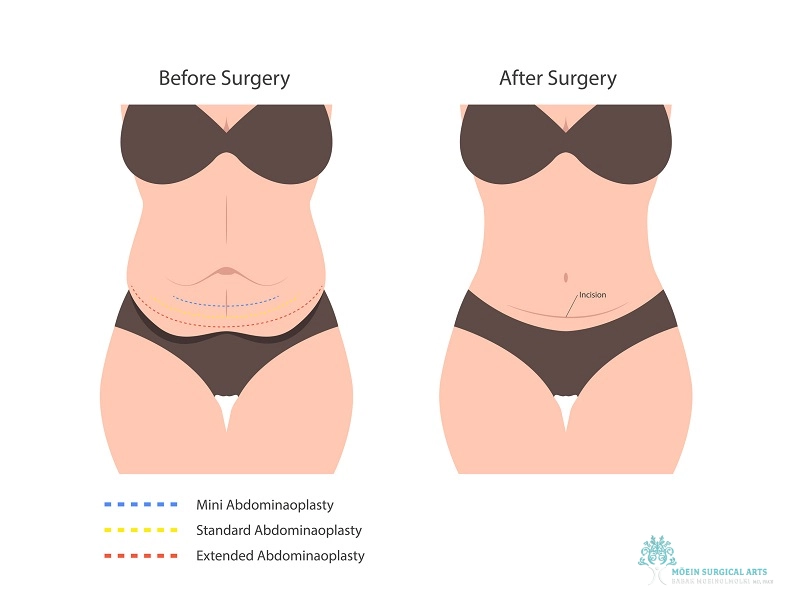
This is the most comprehensive option and the gold standard for moderate to severe diastasis recti.
During a full abdominoplasty, Dr. Moein:
- Removes excess skin and fat
- Tightens the entire abdominal wall (both upper and lower)
- Repairs the linea alba with permanent sutures
- Repositions the belly button for natural aesthetics
It’s not just cosmetic, it’s structural repair.
Patients often say they feel “stronger from the inside out” after this procedure. That’s because it restores core integrity, eliminates sagging, and improves posture and stability.
Best for:
- Postpartum women
- Individuals with major weight loss
- Patients with significant abdominal stretching
Recovery takes several weeks, but the results are life-changing, not only in how you look, but also in how you move and feel.
Laparoscopic Repair Techniques
For patients who want less invasive surgery or those who don’t have cosmetic concerns, laparoscopic repair may be an option.
What’s involved:
- Small incisions
- Use of a tiny camera and surgical tools
- Internal stitching of the separated abdominal muscles
This option has less downtime, minimal scarring, and can be combined with hernia repair if needed.
However, it may not be suitable if:
- You have excess loose skin
- You want a flatter, contoured stomach
- You need cosmetic reshaping in addition to repair
Laparoscopic surgery is typically chosen for function over form, and often covered by insurance if related to a hernia or medical necessity.
Diastasis Repair with Hernia Surgery
Diastasis recti often coexists with hernias, especially around the belly button (umbilical hernia) or along the midline (ventral hernia). Dr. Moein frequently performs combined procedures to treat both conditions in a single surgery.
How it works:
- The hernia is repaired and reinforced
- The diastasis is corrected using internal sutures
- In some cases, a surgical mesh may be placed for extra support
This dual approach:
- Reduces the need for multiple surgeries
- Speeds up total recovery
- Maximizes core strength and durability
If you’ve been told you have a hernia and diastasis, this combined treatment is often the most efficient and effective solution.
Which Option is Right for You?
Your ideal treatment depends on:
- The severity of the muscle separation
- The amount of loose skin or fat
- Whether you have a hernia
- Your aesthetic goals
- Your health status and lifestyle
That’s why every patient at Moein Surgical Arts receives a customized surgical plan.
We don’t believe in one-size-fits-all. We believe in transformational results that last.
Average Cost of Diastasis Surgery
The total cost of surgery varies depending on:
- Type of procedure (mini vs. full tummy tuck vs. laparoscopic repair)
- Whether a hernia repair is included
- Facility and anesthesia fees
- Post-surgical garments and follow-up care
On average, diastasis recti repair surgery at a private practice in Los Angeles ranges between $8,000 and $15,000.
If your surgery includes cosmetic goals like skin tightening, liposuction, or belly button repositioning, that may influence pricing.
Dr. Moein provides a custom quote during your consultation, so you know exactly what to expect based on your unique needs.
Will Insurance Cover the Procedure?
Great question, and the answer is… maybe.
Here’s the breakdown:
Insurance may cover diastasis recti repair if:
- It’s done in conjunction with a hernia repair
- The condition is causing pain, dysfunction, or bowel/bladder issues
- You have documentation from physical therapy showing non-surgical failure
Insurance won’t cover it if:
- The procedure is purely for cosmetic purposes
- You’re doing it only for abdominal appearance
- There’s no functional impairment
This is why many patients opt for combined procedures, such as hernia repair and abdominoplasty, to maximize both insurance and cosmetic benefits.
Dr. Moein and his team can assist you with:
- Pre-authorization requests
- Medical documentation
- Insurance coding for eligible portions
Still unsure? Schedule a consultation to determine what may be covered in your case.
Long-Term Expectations After Diastasis Recti Surgery
Congratulations on completing your journey through consultation, surgery, and recovery. Now it’s time to enjoy the benefits of your new body. Fixing diastasis recti is about more than just appearances; it’s about reclaiming your confidence and improving your quality of life.
Long-Term Results
Once healed, patients often report:
- A flatter, firmer abdomen
- Stronger core muscles
- Better posture and spinal alignment
- Reduced back pain and improved mobility
- Increased self-esteem
Many realize how significantly diastasis recti affected their lives only after it’s resolved, making everyday activities much easier and more enjoyable.
Post-Recovery Exercise Timeline
- Weeks 1–6: Focus on light movement and healing (walking, deep breathing)
- Weeks 6–12: Introduce gentle strength training and stretching (avoid core strain)
- After 12 Weeks: Resume full workouts, including core exercises, with Dr. Moein’s clearance.
You can engage in activities like Pilates, yoga, weightlifting, and cardio, all while enhancing your core strength thanks to restored muscle function.
Emotional and Mental Benefits
Beyond the physical, many patients experience profound emotional changes such as increased confidence, pride in their bodies, and motivation for a healthier lifestyle. This procedure serves as a mental reset, especially for new moms or those feeling disconnected from their core.
Maintaining Your Results
To maintain your improvements, consider the following:
- Stay committed to core-friendly fitness routines
- Avoid sudden weight gain
- Eat a balanced anti-inflammatory diet
- Stay hydrated and support collagen intake with Vitamin C and Zinc
- Follow post-op recovery protocols, including avoiding heavy lifting initially
Regular follow-ups with Dr. Moein can help ensure your results last a lifetime when supported by healthy habits.
Diastasis Recti Surgery Options: Consultation With Dr. Moein
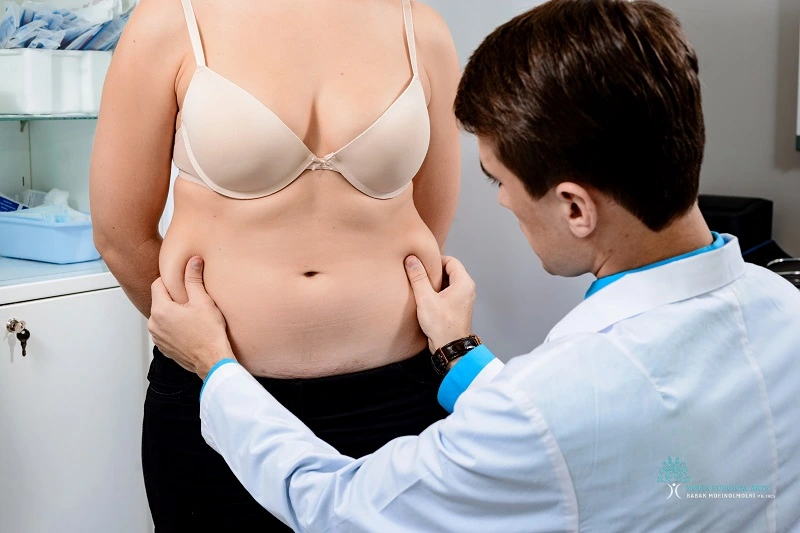
If your abdominal separation is larger than 2.5–3 finger widths, or if physical therapy hasn’t resolved symptoms like bulging, back pain, or weakness after 3–6 months, surgery may be the most effective solution. A consultation with Dr. Moein will help determine your specific needs.
Please feel free to call 310-455-8020 or fill out our secure contact form to book your consultation. During the visit, Dr. Moein will evaluate your condition, discuss your goals, and outline your personalized treatment plan.
]]>In this section, we will delve into the comprehensive details of the Extended Tummy Tuck procedure, along with helpful recovery instructions to ensure a smooth healing process. Additionally, we will showcase astonishing before and after photos that exemplify the transformative results that can be achieved through this surgical technique.
The Extended Tummy Tuck is a highly sought-after procedure designed to address excess skin and stubborn fat in the abdominal area, particularly in individuals who have undergone significant weight loss or multiple pregnancies. This surgical intervention goes beyond a traditional tummy tuck, allowing for a more extensive removal of excess skin and fat, resulting in a more refined and contoured abdominal region.
Throughout this section, we will provide in-depth information on the Extended Tummy Tuck procedure, including the surgical techniques employed, the duration of the surgery, and the expected recovery timeline. We aim to equip you with all the necessary knowledge to make an informed decision and prepare for the intervention.
Furthermore, we understand the importance of a successful recovery, and we will offer detailed instructions to help facilitate a healthy healing process. This will encompass information on post-operative care, activity restrictions, dietary recommendations, and follow-up appointments. Your well-being is of utmost importance to us, and we want to ensure you achieve the best possible outcome.
Lastly, we invite you to explore the captivating before and after photos that vividly portray the exceptional results achieved through Extended Tummy Tuck surgery. Witness the remarkable transformations and envision the potential improvement in your own abdominal contour.
Read on to unravel the wonders of the Extended Tummy Tuck procedure as we walk you through its intricacies, recovery guidelines, and stunning before and after images.
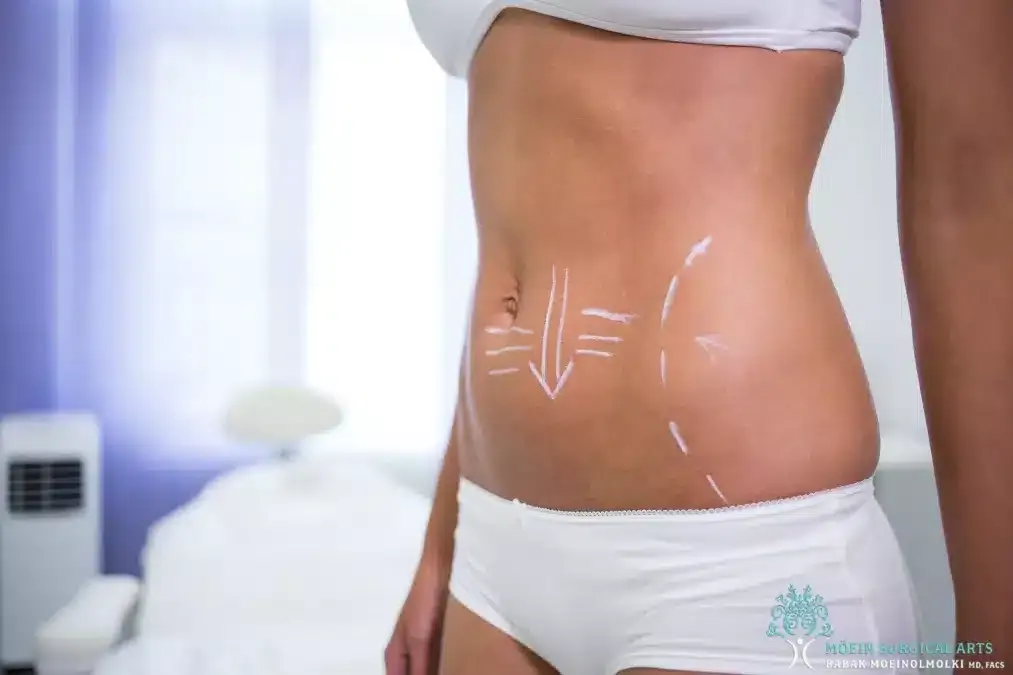
What is an extended tummy tuck?
An extended tummy tuck, also known as a lower body lift, is a surgical procedure that addresses excess skin and fat not only in the abdomen but also in the surrounding areas, such as the waistline, hips, and lower back. This comprehensive approach allows for a more dramatic transformation as it targets multiple areas in one procedure. By removing excess skin and fat and tightening underlying muscles, an extended tummy tuck aims to achieve a flatter, firmer, and more aesthetically pleasing midsection. This procedure is commonly sought by individuals who have experienced significant weight loss or have loose, sagging skin due to aging or multiple pregnancies. The extended tummy tuck offers a personalized solution to contour these areas and restore a toned, youthful appearance. However, it is important to consult with a qualified Cosmetic Surgeon to determine if you are a suitable candidate and to thoroughly discuss the potential risks and benefits associated with this procedure.
Procedure for extended tummy tuck
The procedure for an extended tummy tuck involves several steps to achieve a more sculpted abdominal appearance.
First, the surgeon makes an incision that extends from one hip bone to the other. The incision is typically placed low on the abdomen, just above the pubic area, allowing the resulting scar to be concealed by underwear or swimwear.
After making the incision, the surgeon accesses the underlying muscles. The muscles are then sewn together to create a tighter and firmer abdominal wall. This step helps to improve core strength and posture.
Next, the surgeon modifies the belly button. A new opening is created for the belly button to ensure it is positioned correctly once the excess skin is removed. This helps to maintain a natural-looking appearance.
Once the muscles and belly button have been addressed, the surgeon removes excess fat and skin. Liposuction may be used to target stubborn pockets of fat while the remaining loose skin is pulled tight and surgically removed. This process allows the surgeon to reshape the abdomen and create a flatter, more toned appearance.
Overall, an extended tummy tuck is designed to address not only excess fat and skin but also weak underlying muscles. By following this comprehensive procedure, patients can achieve a more sculpted and contoured abdominal area.
Who is a candidate for an extended tummy tuck?
A candidate for an extended tummy tuck is someone who meets certain criteria and conditions that make them eligible for the procedure. Good health is a crucial factor when considering candidacy for any surgery, including an extended tummy tuck. The individual should be in optimal physical and mental condition without any underlying medical conditions that may interfere with the healing process.
Another determining factor is the Body Mass Index (BMI) of the patient, which should be under 30. This indicates that the person is at a healthy weight and does not have excessive amounts of body fat. People with a BMI over 30 may be advised to lose weight before considering an extended tummy tuck, as the procedure is typically more successful and produces better results when performed on individuals with a lower BMI.
Excess abdominal tissue is also a key consideration for candidacy. The individual should have a significant amount of loose skin and excess fat in the abdominal area that extends to the back. This excess skin and fat can be a result of pregnancy, genetics, or significant weight loss. Candidates with significant weight loss often find an extended tummy tuck beneficial since it helps remove the excess skin and tighten the underlying muscles.
In summary, a candidate for an extended tummy tuck should be in good health, have a BMI under 30, have excess abdominal tissue extending to the back, and may have experienced significant weight loss. These factors are important in determining candidacy for the procedure and will help ensure the best possible outcome for the patient.
How does an extended tummy tuck work?
An extended tummy tuck, also known as an abdominoplasty, is a surgical procedure designed to enhance the appearance of the abdomen. This comprehensive approach addresses not only excess fat and loose skin in the front of the abdomen but also extends the contouring to the sides and back areas. By combining traditional tummy-tuck techniques with additional incisions, an extended tummy tuck provides a more complete rejuvenation of the abdominal region, delivering a tighter, smoother, and more toned appearance. This article explores the detailed process involved in an extended tummy-tuck surgery, shedding light on how this procedure effectively transforms the abdominal area and achieves the desired aesthetic results.
What are the results of the extended tummy tuck?
The extended tummy tuck procedure yields remarkable results in terms of contour and appearance. Addressing multiple areas effectively reduces excess skin and fat, resulting in a slimming effect on the stomach, flanks, and love handles.
One of the key areas addressed during the extended tummy tuck is the lower abdomen. This procedure allows for the removal of excess skin and fat in this region, creating a flatter and more toned appearance. It is particularly beneficial for individuals who have experienced significant weight loss or pregnancy, as it targets the loose skin that may be resistant to exercise or dieting.
Another area addressed in the extended tummy tuck is the flanks, commonly known as the “muffin top.” This procedure helps to eliminate the stubborn fat deposits and sagging skin on the sides of the waist, resulting in a smoother and more streamlined silhouette. The slimming effect achieved on the flanks enhances the overall appearance of the midsection.
Furthermore, the extended tummy tuck also improves the appearance of love handles, which are the fat deposits that accumulate on the hips. Removing excess fat and skin in this area creates a more defined waistline and enhances the hourglass figure.
In summary, the extended tummy tuck procedure delivers exceptional results by addressing various areas, including the lower abdomen, flanks, and love handles. It enhances the contour and appearance of the midsection, reducing excess skin and fat and providing a slimming effect.
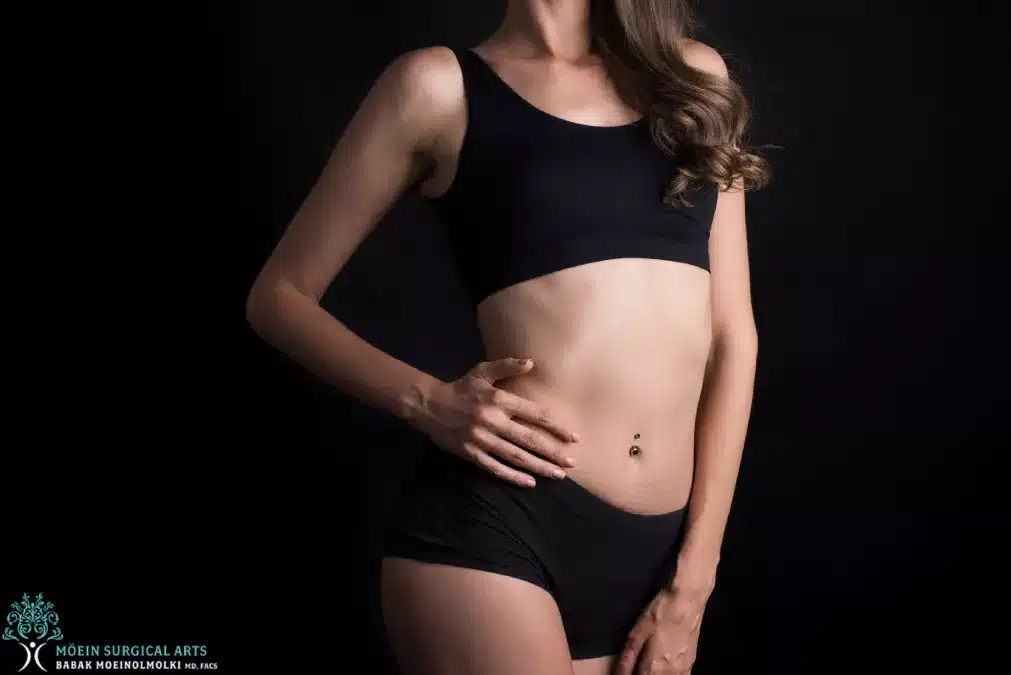
How long are the incisions on an extended tummy tuck?
An extended tummy tuck is a surgical procedure that aims to remove excess skin and fat from the stomach, flanks, and sometimes the lateral thigh. One of the key aspects of the procedure is the length of the incisions, which are typically made along the bikini line to ensure they can be hidden beneath underwear or swimwear.
The length of the incisions varies depending on each individual’s body and the amount of excess skin that needs to be removed. However, in general, the incisions can range from hip to hip, extending beyond the bikini line on either side. This allows the surgeon to access the areas where excess skin and fat need to be addressed.
In addition to the incisions along the bikini line, the extended tummy tuck may also involve repositioning the belly button to achieve a more natural appearance. This is done by creating a new opening for the belly button and then suturing it back into place in its new position.
The steps involved in an extended tummy tuck typically include anesthesia, making the necessary incisions, removing excess skin and fat, tightening the underlying muscles if needed, repositioning the belly button, and closing the incisions with sutures. The purpose of this procedure is to create a smoother, flatter abdominal contour and improve the overall appearance of the stomach, flanks, and sometimes the lateral thigh.
Overall, an extended tummy tuck is a comprehensive surgical procedure that requires incisions of varying length along the bikini line. By removing excess skin and fat and repositioning the belly button, this procedure aims to create a more toned and aesthetically pleasing abdominal area.
What is the recovery like for an extended tummy tuck?
Recovery after an extended tummy tuck, also known as an abdominoplasty, requires careful adherence to post-operative instructions to ensure optimal healing. The recovery timeline can vary depending on the individual, but generally, it takes around six to eight weeks for the initial healing process.
During the first few days after the surgery, patients can expect some discomfort and swelling in the abdominal area. Pain medication and compression garments may be prescribed to reduce swelling and promote healing. It is important to rest and avoid strenuous activities during this time.
Around two weeks after the procedure, most patients can return to work, although it is essential to continue wearing the compression garment for support. Light activities can be gradually resumed, while strenuous exercises should be avoided for at least six weeks.
In the following weeks, the swelling will continue to subside, and the scars from the incisions will begin to fade. It is crucial to follow the provided post-operative instructions, including keeping the incision area clean and dry to minimize the risk of infection. Regular follow-up visits with the surgeon are necessary to monitor the healing process and address any concerns.
While complications or risks are rare, it is important to be aware of the potential risks associated with an extended tummy tuck. These can include bleeding, infection, scarring, asymmetry, or changes in sensation around the incision site. By following the post-operative instructions and seeking prompt medical attention if any concerns arise, the risks can be minimized.
In conclusion, the recovery process for an extended tummy tuck requires patience and adherence to post-operative instructions. Understanding the healing stages, following the recommended timeline, and being aware of potential risks and complications will ensure a smooth recovery and satisfactory results.
Targeted areas for extended tummy tuck
The targeted areas for an extended tummy tuck procedure, as mentioned in the Background Information, include the upper and lower stomach, waist, flanks, and the uppermost lateral portion of the thigh.
During an extended tummy tuck procedure, excess fat, skin, and tissue are removed from the upper and lower stomach to create a smoother and firmer abdominal contour. The procedure is particularly effective in addressing excess skin and muscle separation that may result from pregnancy, weight loss, or aging.
The waist is another targeted area for an extended tummy tuck. The procedure focuses on removing excess skin and fat deposits, resulting in a slimmer waistline. By contouring the waist, the extended tummy tuck helps to create a more defined and proportionate silhouette.
In addition to the stomach and waist, the flanks are also addressed during an extended tummy tuck. This procedure aims to eliminate stubborn love handles or “muffin tops” by removing excess fat and skin along the sides of the body. By targeting the flanks, the extended tummy tuck can enhance the overall appearance of the midsection, providing a smoother and more aesthetically pleasing contour.
Finally, an extended tummy tuck may also address the uppermost lateral portion of the thigh, commonly known as the saddlebags. This area, often difficult to improve with diet and exercise alone, can be effectively targeted during the procedure, resulting in a more balanced and harmonious lower body shape.
Overall, the targeted areas for an extended tummy tuck procedure include the upper and lower stomach, waist, flanks, and the uppermost lateral portion of the thigh. By addressing these areas, the extended tummy tuck aims to create a more toned and proportionate appearance, helping individuals achieve their desired body contour.
Extended tummy tuck vs. traditional tummy tuck
An extended tummy tuck and a traditional tummy tuck are both types of cosmetic surgical procedures aimed at improving the appearance of the abdominal area. However, there are key differences between the two procedures.
One of the main differences between an extended tummy tuck and a traditional tummy tuck is the areas addressed during the surgery. A traditional tummy tuck primarily focuses on removing excess skin and fat from the lower abdomen, as well as tightening the muscles in that area. On the other hand, an extended tummy tuck not only addresses the lower abdomen but also extends to the hips and flanks, allowing for a more comprehensive contouring of the waistline.
Another difference between the two procedures is the length of the resulting scar. In a traditional tummy tuck, the incision is typically made horizontally across the lower abdomen, from hip bone to hip bone, and often results in a scar that can be easily concealed within underwear or swimsuits. In contrast, an extended tummy tuck requires a longer incision that extends further into the hip and flank area, resulting in a longer scar.
The specific goals achieved by each procedure are also distinct. A traditional tummy tuck primarily aims to create a flatter, tighter abdomen by removing excess skin and fat and tightening abdominal muscles. It is most effective for patients with moderate to severe skin laxity and muscle separation. An extended tummy tuck, on the other hand, not only targets these goals but also provides additional contouring of the waistline and hips, resulting in a more hourglass figure. It is often preferred by patients who desire a more comprehensive transformation of their abdominal and waistline appearance.
In conclusion, while both the extended tummy tuck and traditional tummy tuck aim to improve the appearance of the abdominal area, they differ in terms of areas addressed, scar length, and specific goals. Understanding these differences is crucial in determining which procedure is most suitable for an individual’s unique needs and desired outcome.
Conclusion: Extended Tummy Tuck Before and After
In conclusion, the extended tummy tuck procedure is a comprehensive surgical option for individuals seeking significant improvement in their abdominal contour. As described in the background section, this procedure involves the removal of excess skin and fat, as well as tightening of the abdominal muscles, resulting in a flatter and more toned abdomen.
The recovery process following an extended tummy tuck typically requires adequate rest and adherence to post-operative instructions, including wearing compression garments and avoiding strenuous activities. While each patient’s experience may vary, it is important to note that the recovery period can last several weeks to months, during which the body gradually heals and the final results slowly emerge.
The purpose of this section is to provide a conclusion on the before and after results of the extended tummy tuck procedure. It is important to note that individual outcomes may differ based on factors such as pre-existing conditions, body type, and overall health. However, in general, patients can expect to see a drastic improvement in their abdominal appearance, with a significant reduction in excess skin and a more sculpted contour.
In summary, the extended tummy tuck procedure offers remarkable transformations, allowing individuals to achieve their desired aesthetic goals. It is important to consult with a qualified Cosmetic Surgeon to understand the potential before and after results, as well as to discuss any concerns or questions related to the procedure. With proper care and adherence to post-operative instructions, patients can expect a positive outcome and enhanced self-confidence.
]]>The six-week mark after undergoing a tummy tuck procedure is a crucial milestone in the recovery process. By this time, patients can expect significant progress in their healing journey. This section will delve into the various aspects of the recovery timeline, potential side effects, and the importance of follow-up appointments at this point.

Reaching the six-week mark signifies a substantial step towards regaining full functionality and normalcy. By this time, patients often experience a reduction in pain and discomfort, and their incisions begin to heal significantly. It is during this period that individuals may gradually resume their usual activities, including exercising and lifting more substantial weights, under the guidance of their surgeon.
While the initial weeks post-operative are crucial for healing, the six-week mark is when patients can expect to see more pronounced improvement in their body contour and overall well-being. Specific side effects, such as swelling and bruising, will continue to diminish during this period.
It is essential to mention that individual patients may experience a variation in their healing timeline and potential side effects. However, these are topics that will be explored further in subsequent sections. Additionally, scheduling follow-up appointments with the surgeon is crucial at this point to ensure that progress is monitored and any concerns are addressed promptly.
In conclusion, the six-week post-operative period after a tummy tuck marks a significant recovery milestone. In the following sections, we will discuss in detail the specific progress, potential side effects, and the importance of following up with your surgeon during this stage of the healing process.
Your Week by Week Tummy Tuck Recovery Timeline
The recovery process following a tummy tuck, also known as an abdominoplasty, is crucial for achieving optimal results and ensuring a smooth healing journey. In this post, we will provide a week-by-week guide to help you understand the phases of tummy tuck recovery and what to expect during each stage. From immediately after surgery to several weeks post-op, we will take you through the timeline of recovery, highlighting essential milestones and offering helpful tips for a successful and comfortable healing experience. Let’s delve into the week-by-week tummy tuck recovery timeline.
Day 1 of Tummy Tuck Surgery
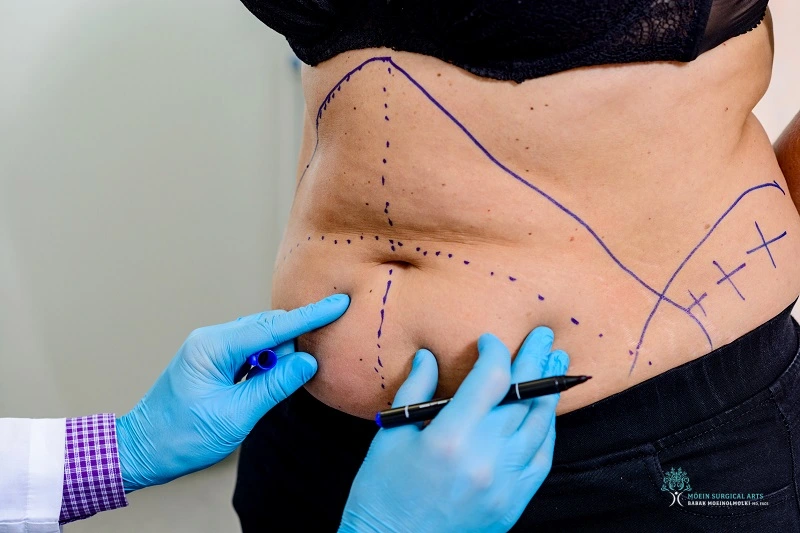
Day 1 of tummy tuck surgery marks an important step towards achieving a more contoured abdomen. Upon completion of the procedure, patients will require assistance to return home, as the effects of general anesthesia will leave them feeling groggy and unable to drive. It is crucial to arrange for a responsible adult to accompany and provide transportation.
In the initial hours following the surgery, patients will experience grogginess due to the anesthesia. This grogginess generally lasts for several hours, during which time the patient is advised to rest and refrain from any strenuous activities. The patient may also feel some discomfort, which is typical after this type of surgery. This discomfort can range from mild to moderate and may be managed with prescribed pain medication.
Given the significance of Day 1 in the recovery process, rest is highly recommended to aid the healing process. While it is important to move around periodically to promote blood circulation, it is crucial to avoid any strenuous activities for the first day. It is also essential to follow the surgeon’s instructions concerning post-operative care, such as dietary restrictions and proper wound care.
In summary, on Day 1 of tummy tuck surgery, a designated driver is necessary due to the grogginess experienced after general anesthesia. Patients can anticipate discomfort which can be alleviated by prescribed medication. Rest is crucial during this period to promote healing, with minimal physical activities advised.
Week 1 After Surgery
During the first week of tummy tuck recovery, it is crucial to strictly adhere to the recommended restrictions in order to ensure proper healing and minimize any potential complications. The following activities should be avoided during this period:
- Bed rest: Resting and staying in bed as much as possible is essential for a successful recovery. This promotes healing and reduces strain on the abdominal muscles.
- Limited activity: It is important to avoid any vigorous or strenuous activities during the first week. This includes activities that require bending, twisting, or stretching the abdominal area.
- Lifting and carrying: The lifting of heavy objects should be strictly avoided during the initial recovery period. Lifting and carrying heavy weights can strain the healing incisions and internal tissues, causing complications.
- Driving: Driving should be avoided during the first week of recovery. The abdominal muscles play a vital role in maintaining proper control of the vehicle, and any sudden movements or emergency braking can cause pain, discomfort, or potential damage to the healing incisions.
- Exercise: Any form of exercise or physical activity that engages the abdominal muscles should be postponed for at least a week. This includes activities such as jogging, running, weightlifting, or intense cardio workouts.
It is important to consult with the surgeon for specific guidelines and restrictions tailored to the individual’s condition and needs. Compliance with these instructions will help ensure a smooth and successful recovery from a tummy tuck surgery.
Week 2 After Surgery
During week 2 of tummy tuck recovery, it is crucial to avoid certain activities that may hinder the healing process and affect the optimal results of the procedure. Firstly, vigorous exercise should be completely avoided. This includes activities such as running, weightlifting, and high-intensity workouts. Engaging in these activities too soon can put strain on the healing incisions, leading to complications and delays in the recovery process.
Additionally, it is important to refrain from smoking and drinking alcohol during week 2 and beyond. Smoking delays the healing process by constricting blood vessels and restricting oxygen flow, while alcohol can interfere with medications and increase the risk of complications. Both substances can also impair the body’s ability to heal and increase the risk of infection.
In terms of diet, it is advised to continue limiting sodium intake and drinking plenty of water. Reducing sodium intake can help prevent excessive swelling, while staying well-hydrated promotes overall healing and aids in flushing out toxins from the body.
To optimize healing and achieve desirable results, patients should lightly massage the treated area as advised by their surgeon. Massaging can help improve blood circulation and promote tissue healing. Additionally, using scar minimizing techniques, such as silicone sheets or silicone gel, can help reduce the appearance of scars over time. Lastly, wearing compression garments, as instructed by the surgeon, promotes proper healing by providing support to the treated area and reducing swelling.
By following these guidelines and avoiding certain activities, maintaining a healthy diet, practicing scar minimizing techniques, and utilizing compression garments, patients can experience optimal healing and achieve the best possible results after a tummy tuck procedure.
Week 3 after Surgery
During week 3 of tummy tuck recovery, it is important to continue following post-operative instructions to ensure proper healing and minimize complications. While restrictions from physical activity are gradually lifted, it is crucial to proceed with caution and avoid strenuous exercises.
Specific activities during week 3 can include gentle walking and light stretching to gradually increase mobility. However, heavy lifting, vigorous workouts, and activities that strain the abdominal muscles should still be avoided. It is advisable to consult with the surgeon before starting any new exercise routine.
Precautions should also be taken during week 3 to protect the incision site and promote healing. It is essential to observe proper scar care by keeping the incision clean and dry, avoiding direct sunlight, and applying any prescribed ointments or dressings. Wearing loose-fitting clothing or compression garments can help reduce swelling and support the healing process.
Following a well-balanced diet that includes ample protein, vitamins, and minerals is important for optimal healing. Staying hydrated and getting sufficient rest are also key factors in promoting a speedy recovery.
In summary, week 3 of tummy tuck recovery involves gradually increasing physical activity, maintaining proper scar care, and following a healthy lifestyle. It is crucial to adhere to the post-operative instructions and consult with the surgeon for personalized advice.
Week 4 After Surgery
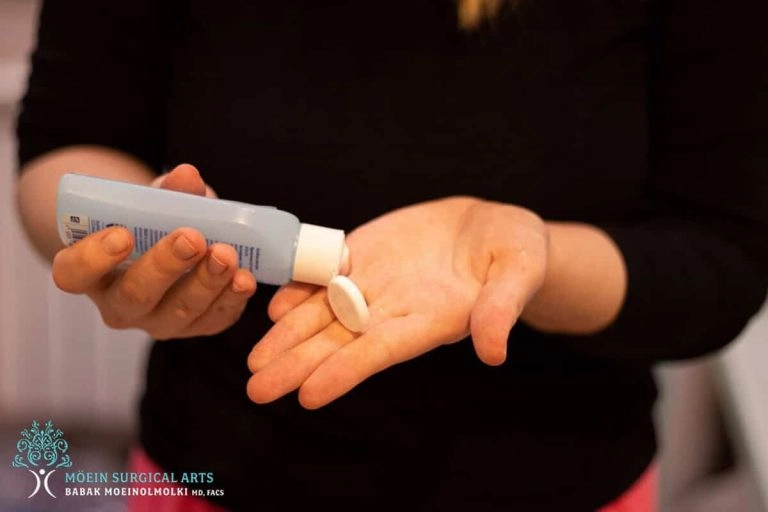
During week 4 of tummy tuck recovery, it is important to continue addressing key points such as gradually increasing physical activity, scar care, maintaining a healthy diet, and additional restrictions or precautions.
Gradually increasing physical activity is crucial during this stage of recovery. While it is important to stay active to promote healing and prevent blood clots, sudden, intense exercises should be avoided. Patients can begin with light walking or stretching exercises and slowly progress to more strenuous activities. It is important to listen to the body’s signals and not push too hard, as overexertion can delay healing.
Continuing scar care is essential in week 4 of tummy tuck recovery. Regularly cleaning the incision area with mild soap and water and gently patting it dry is recommended. Applying silicone gel or sheets can help minimize scarring. Massaging the scar with lotion or oil can also aid in reducing its appearance. It is vital to avoid exposing the scar to direct sunlight and wearing tight clothing that may irritate the incision site.
Maintaining a healthy diet is important for proper healing during week 4 of tummy tuck recovery. Consuming a balanced diet that is rich in vitamins, minerals, and protein will support the body’s healing process. Staying hydrated is also crucial as it assists in wound healing and prevents complications.
Additional restrictions and precautions include avoiding heavy lifting, bending, or straining the abdominal muscles. Patients should also refrain from smoking and consuming alcohol, as these can impede the healing process. It is important to attend all follow-up appointments with the surgeon during week 4 to monitor progress and address any concerns promptly.
In conclusion, week 4 of tummy tuck recovery requires a gradual increase in physical activity, continued scar care, maintaining a healthy diet, and adhering to additional restrictions and precautions. By following these guidelines, patients can promote proper healing and achieve optimal results from their tummy tuck surgery.
Week 5 after Surgery
During week 5 after tummy tuck surgery, it is important to continue following specific activities, dietary guidelines, and care instructions to ensure a successful recovery.
Activities:
- Light exercise: You can gradually increase your activity level, incorporating light walking or stretching into your routine. However, avoid any strenuous exercise until you receive approval from your surgeon.
- Avoid heavy lifting: Do not engage in heavy lifting or any activities that put excessive strain on your abdominal muscles for at least another week.
- Daily movements: Focus on maintaining good posture and avoiding any sudden or jerky movements that may strain your incision site.
Dietary guidelines:
- Maintain a healthy diet: Continue to eat a balanced diet rich in fruits, vegetables, lean proteins, and whole grains. This will assist in the healing process.
- Hydration: Drink plenty of water to stay hydrated and promote proper circulation.
Care instructions:
- Scar treatments: Follow your surgeon’s recommendations for scar treatment. This may include applying ointments or creams and keeping the incision site clean and dry.
- Compression garments: Continue wearing compression garments as advised by your surgeon. These garments provide support to the abdominal area, minimize swelling, and aid in shaping your new contours.
- Regular check-ups: Attend your scheduled follow-up appointments with your surgeon. They will evaluate your progress, make any necessary adjustments to your treatment plan, and provide further guidance.
Strenuous exercise can be resumed only with your surgeon’s approval to prevent any complications. Additionally, maintaining a healthy diet, consistently following scar treatments, and wearing compression garments will contribute to optimal healing and results.
Have Questions About Your Tummy Tuck Recovery?
Get expert guidance from Dr. Moein on your personalized recovery timeline and what to expect at every stage of healing.
 Call Now: (310) 455-8020
Call Now: (310) 455-8020  Request Free Consultation
Request Free Consultation✓ Board-Certified Surgeon • ✓ Personalized Care • ✓ Los Angeles Premier Facility
Week 6 After Surgery
During week 6 after surgery, it is crucial for patients to continue following their post-operative care routine in order to aid in their recovery process. This week marks an important milestone as patients can begin to gradually resume certain activities, with prior approval from their surgeon.
One key aspect of the post-operative care routine that should be continued during week 6 is applying scar treatments. Applying these treatments, such as creams or ointments, can help minimize the appearance of scars and promote faster healing. Patients should carefully follow the instructions provided by their healthcare provider when applying these treatments.
Additionally, wearing compression garments should still be a priority during week 6. These garments help reduce swelling, promote blood circulation, and provide support to the treated areas. Consistently wearing compression garments aids in the overall recovery process.
Maintaining a healthy diet is also crucial during week 6 after surgery. Consuming a balanced diet rich in nutrients supports the body’s healing process. Patients should focus on including fruits, vegetables, lean proteins, and whole grains in their meals to provide the necessary vitamins and minerals for optimal recovery.
With the approval of their surgeon, patients can gradually start resuming certain activities during week 6. These activities may include light household chores, walking short distances, or engaging in low-impact exercises. It is important to follow the surgeon’s guidelines and take things slowly to avoid any complications or setbacks.
In summary, week 6 after surgery requires patients to continue with scar treatments, wearing compression garments, and maintaining a healthy diet. The resumption of certain activities can be gradually initiated with the approval of the surgeon. By following these instructions, patients can ensure a successful and smooth recovery process.
Tummy Tuck Recovery Tips
Tummy tuck recovery tips are essential for anyone considering or undergoing this popular cosmetic surgery procedure. A tummy tuck, also known as an abdominoplasty, is a surgical procedure that removes excess fat and skin from the abdominal area, resulting in a flatter and more toned midsection. While the surgery itself is significant, the recovery process is equally important in ensuring optimal results and a smooth healing experience. By following specific recovery tips, individuals can minimize discomfort, reduce the risk of complications, and shorten their overall recovery time. In this article, we will explore some valuable tummy tuck recovery tips that will aid patients in achieving a successful and comfortable recuperation after their surgery.
Compression Garments after Abdominoplasty

Compression garments play a crucial role in tummy tuck recovery by providing support and aiding in the healing process. These specially designed garments apply gentle pressure to the treated area, offering a multitude of benefits.
One of the most significant advantages of compression garments is their ability to prevent fluid buildup. After a tummy tuck procedure, the body naturally produces excess fluid as part of the healing process. Compression garments help to reduce the amount of fluid buildup by promoting proper drainage. This helps to minimize the risk of complications, such as seroma formation, which occurs when fluid accumulates under the skin.
In addition to preventing fluid buildup, compression garments also help in reducing post-surgical swelling. The gentle compression provided by these garments helps to support the tissues, minimizing excessive swelling and promoting faster healing. Swelling can cause discomfort and limit mobility, so reducing it is crucial for a smoother recovery.
Compression garments also play a vital role in protecting the incision sites. They provide a barrier between the incisions and external elements, reducing the risk of infection and improving wound healing. By keeping the incision sites secure and protected, compression garments contribute to a better overall healing process.
Another advantage of compression garments is their ability to contour the abdomen. These garments provide support and compression that helps mold the tissues, promoting a smoother and more even result. They can help to minimize the appearance of irregularities and create a more aesthetically pleasing contour.
Lastly, compression garments can minimize the risk of wound breakdown. The pressure applied by these garments helps to stabilize the tissues, reducing tension on the incisions. This can help to prevent wound separation or opening, resulting in more successful healing.
In conclusion, compression garments are an essential component of tummy tuck recovery. They aid in preventing fluid buildup, reducing post-surgical swelling, protecting incision sites, contouring the abdomen, and minimizing the risk of wound breakdown. By wearing compression garments as recommended by the surgeon, patients can experience a smoother and faster recovery process.
Walker
A front-wheeled walker is a mobility aid commonly used in the recovery process following surgery. Its purpose is to provide stability and support to individuals who have limited balance or strength, allowing them to regain their mobility with ease. By using a front-wheeled walker, patients can experience several key benefits.
Firstly, a front-wheeled walker aids in walking with a safe posture. This is crucial during the recovery period as it reduces the risk of falls and further injury. The design of the walker enables the user to maintain a slightly bent-over posture, which promotes stability and prevents strain on the back muscles. This ensures that the body is properly aligned during the walking process, minimizing the likelihood of accidents and allowing for a more controlled and secure movement.
Moreover, the front-wheeled walker reduces pressure on the back muscles. When recovering from surgery, individuals may experience pain and discomfort in their back muscles due to the surgical procedure and limited movement. By using a front-wheeled walker, the pressure on the back muscles is alleviated, as the walker bears the weight of the upper body. This enables individuals to navigate their surroundings and engage in walking exercises without straining their back muscles, thus promoting a faster and less painful recovery.
In conclusion, utilizing a front-wheeled walker in the recovery process after surgery has various advantages. It assists in maintaining a safe, slightly bent-over posture, which reduces the risk of falls and promotes stability. Additionally, it minimizes pressure on the back muscles, allowing for a more comfortable rehabilitation experience. Overall, a front-wheeled walker is an essential aid that facilitates mobility and enhances the recovery journey after surgery.
Wound Care Supplies
Wound Care Supplies:
When it comes to wound care, having the necessary supplies on hand is essential for proper healing and to prevent infection. Here is a list of the necessary wound care supplies, including gauze pads, to address various types of wounds, including incisions:
- Gauze Pads: As mentioned in the Background Information, gauze pads are essential for covering incisions. These sterile pads are designed to absorb drainage and protect the incision from contamination. They are available in different sizes to accommodate different wound sizes.
- Adhesive Bandages: These are commonly referred to as “band-aids” and are used to cover smaller, less severe wounds. They have an adhesive backing that sticks to the skin, providing a barrier to dirt and bacteria.
- Tape: Medical adhesive tape is used to secure dressings and bandages in place. It is hypoallergenic and gentle on the skin, making it suitable for use on sensitive areas.
- Antiseptic Solution: An antiseptic solution, such as hydrogen peroxide or povidone-iodine, is used to clean the wound before dressing it. It helps to kill bacteria and prevent infection.
- Antibiotic Ointment: Applying an antibiotic ointment helps to promote healing and prevent infection. It can be applied to the wound before covering it with a dressing.
- Sterile Gloves: Wearing sterile gloves while treating a wound is important to maintain a clean and sterile environment. It helps to prevent the transfer of bacteria from the hands to the wound.
- Sterile Saline Solution: Sterile saline solution can be used to irrigate and cleanse wounds. It is gentle on the tissues and helps to remove debris and bacteria.
Remember, it is important to consult a healthcare professional or follow medical guidelines for proper wound care. This list provides a basic overview of the necessary wound care supplies, but the specific requirements may vary depending on the severity and type of wound.
OTC Pain Medication after Tummy Tuck

Over-the-counter (OTC) pain medication plays a significant role in managing post-operative pain. After undergoing surgery, patients commonly experience discomfort and pain during the recovery process. OTC pain medication can be an effective and accessible option for relieving post-operative pain and improving the patient’s overall well-being.
There are several types of OTC pain medication commonly used for managing post-operative pain. Nonsteroidal anti-inflammatory drugs (NSAIDs) such as ibuprofen and aspirin are frequently used due to their dual action of reducing pain and inflammation. Acetaminophen, another commonly used OTC pain reliever, focuses primarily on reducing pain and does not have the anti-inflammatory properties of NSAIDs.
The benefits of OTC pain medication for post-operative pain management are numerous. These medications are easily accessible, allowing patients to obtain relief without a prescription. They are also typically less expensive compared to prescription pain medications, making them more affordable for patients. OTC pain medications also offer various dosage forms, such as tablets, capsules, and liquid formulations, providing flexibility for individual preferences.
Despite the benefits, it is important to be aware of potential side effects that may arise from using OTC pain medication. NSAIDs, for example, can irritate the stomach lining and may increase the risk of gastrointestinal bleeding. Acetaminophen, if taken in excessive amounts, may cause liver damage. It is essential to follow the recommended dosage and seek medical advice if any adverse effects are experienced.
In conclusion, OTC pain medication is highly relevant in managing post-operative pain. Their accessibility, affordability, and effectiveness make them a practical choice for patients. However, it is crucial to understand the types of OTC pain medications available, their benefits, and potential side effects to ensure safe and appropriate usage.
Tummy Tuck Scar Treatment: Scar Gel
Scar Gel is a highly effective scar treatment that aims to diminish the appearance of scars after incision sites have fully healed. This revolutionary gel provides an array of benefits and has gained immense popularity in the field of scar management.
The primary benefit of Scar Gel lies in its ability to significantly reduce the visibility of scars. By applying the gel to the affected area, it works to improve the skin’s texture and color, gradually fading the scar. It also helps to smoothen and soften the skin, making the scar less noticeable and more aesthetically pleasing.
To achieve optimal results, Scar Gel should be applied to fully healed incision sites. It is recommended to use the gel twice daily, gently massaging it in circular motions until fully absorbed. Consistent usage is key to achieving desired outcomes, and it is important to be patient, as the speed of results may vary depending on the severity of the scar.
The key features of Scar Gel include its non-greasy formula, which allows for easy application and quick absorption into the skin. It is also fragrance-free and does not contain any potentially irritating ingredients, making it suitable for sensitive skin types.
The powerful ingredients of Scar Gel include a unique blend of botanical extracts, such as aloe vera and onion extract, which have been scientifically proven to improve scar appearance. Additionally, it contains silicone, which forms a protective layer over the scar, preventing excessive moisture loss and enabling optimal healing conditions.
In conclusion, Scar Gel offers a multitude of benefits for scar treatment, effectively diminishing the appearance of scars after incision sites have fully healed. With its easy application process and key ingredients, this gel provides a reliable solution for scar management, ensuring improved skin texture and color.

Recliner
Using a recliner for sleep during recovery offers numerous benefits, especially when the patient needs to sleep at a 45-degree angle for an extended period. One of the key advantages is that a recliner provides the optimal angle for reducing strain on the body and promoting effective healing. By elevating the upper body and legs, pressure is relieved from the back and joints, allowing the body to relax and heal more efficiently.
Compared to sleeping in a bed, patients often find a recliner much more comfortable during the recovery phase. The adjustable positions of a recliner enable individuals to find the perfect angle that suits their specific needs. This customization allows for personalized comfort, reduces discomfort caused by medical devices or injuries, and promotes better sleep quality. Additionally, recliners often have built-in lumbar support and cushioning, which further enhance comfort and alleviate any pain or discomfort.
In cases where a reclining chair is not readily available, it is highly recommended to rent one for the recovery period. Renting a recliner offers a cost-effective solution, as it allows patients to have access to the necessary equipment without the need for a significant investment. Moreover, rental recliners are often maintained in excellent condition, ensuring optimal functionality and comfort for the patient’s recovery needs.
In conclusion, using a recliner for sleep during recovery provides essential benefits such as the ability to maintain a 45-degree angle and alleviate strain on the body. Its superior comfort compared to beds makes it an ideal choice for patients. Renting a reclining chair is a practical option to ensure the patient’s comfort and aid in their recovery process.
Tummy Tuck Recovery Week by Week Tips
Tummy tuck procedures are quite common, but the recovery process can be challenging. To ensure a smooth and comfortable recovery, several tips can be followed.
Maintaining a healthy diet is crucial during tummy tuck recovery. Eating a balanced diet rich in fruits, vegetables, lean proteins, and whole grains helps the body heal faster and provides essential nutrients. It promotes tissue repair, reduces inflammation, and boosts the immune system. Additionally, drinking an adequate amount of water is essential to stay hydrated, flush out toxins, and prevent constipation.
Taking probiotics is another beneficial step for tummy tuck recovery. Probiotics help restore the balance of gut bacteria, which can be disrupted due to surgical procedures and antibiotic use. This promotes healthy digestion, reduces bloating, and enhances nutrient absorption.
Consuming ginger tea is recommended as it can alleviate nausea and aid digestion. Ginger has anti-inflammatory properties that can help reduce swelling and discomfort after a tummy tuck.
Using arnica gel or cream can also contribute to a comfortable recovery. Arnica is a natural remedy that can reduce bruising, swelling, and pain. Gently massaging the gel or cream onto the affected areas can speed up the healing process.
In conclusion, following these tummy tuck recovery tips, including maintaining a healthy diet, drinking water, taking probiotics, consuming ginger tea, and using arnica gel or cream, can greatly aid in a comfortable and successful recovery. It is important to consult with a healthcare professional for personalized advice based on individual circumstances.
Conclusion: 6 Weeks Post op Tummy Tuck
In conclusion, the recovery process at 6 weeks post-op for a tummy tuck procedure is crucial for achieving optimal results. At this stage, patients can expect significant progress in their recovery and overall well-being.
One of the key points in the recovery process is maintaining a healthy lifestyle. This includes following a balanced diet and exercise routine. A healthy diet helps support the body’s healing process and aids in reducing swelling and inflammation. Similarly, regular exercise promotes blood circulation and muscle tone, which can enhance the outcome of the tummy tuck by improving the overall aesthetic appearance of the abdomen.
Wearing a compression garment is another essential aspect of recovery. This garment helps to minimize swelling, promote drainage of excess fluid, and provide support to the treated area. By wearing the compression garment as directed, patients can experience faster recovery and an improved contour of their abdomen.
Furthermore, scheduling lymphatic drainage massages can greatly contribute to the recovery process. These specialized massages help to reduce swelling, improve circulation, and enhance the elimination of toxins from the body. By promoting lymphatic drainage, patients can achieve a smoother and more refined appearance of their abdomen.
In conclusion, the recovery process at 6 weeks post-op for a tummy tuck is dependent on maintaining a healthy lifestyle, wearing a compression garment, and scheduling lymphatic drainage massages. By adhering to these factors, patients can expect to see significant progress in their recovery and experience the desired results of their tummy tuck procedure.
Ready to Transform Your Body?
Schedule your tummy tuck consultation with Dr. Moein today and discover how expertly planned recovery leads to exceptional results.
 Call: (310) 455-8020
Call: (310) 455-8020  Book Consultation
Book ConsultationCan’t Visit In Person? No Problem!
 Schedule Virtual Consultation
Schedule Virtual ConsultationThe average tummy tuck cost in California typically ranges from $8,000 to $15,000 or more, depending on the complexity of the surgery and the need for additional procedures such as liposuction or muscle repair. Prices tend to be higher in major metropolitan areas like Los Angeles, where demand, facility costs, and access to highly trained specialists all play a role. At Moein Surgical Arts in Los Angeles, double-board-certified cosmetic surgeon Dr. Babak Moein provides individualized quotes based on your anatomy, goals, and safety profile rather than a one-price-fits-all package.
Several key factors influence what you will ultimately pay for a tummy tuck in Southern California. These include the type of abdominoplasty performed (mini, standard, extended, or Fleur-de-Lis), the amount of skin and fat to be removed, whether muscle tightening or hernia repair is required, and the time needed for the operating room. The surgeon’s expertise and reputation, the use of a fully accredited surgical facility, and the involvement of a board-certified anesthesiologist also affect the total cost. In addition, post-operative expenses, such as compression garments, medications, and follow-up care, are part of the overall investment.
Despite these expenses, many patients consider a tummy tuck a transformative procedure that can restore abdominal contour, improve clothing comfort, and enhance self-confidence after pregnancy or significant weight loss. In the sections that follow, we will look more closely at how each of these variables affects tummy tuck pricing in California and how Dr. Moein structures his fees to provide safe, high-quality results with transparent, predictable costs.
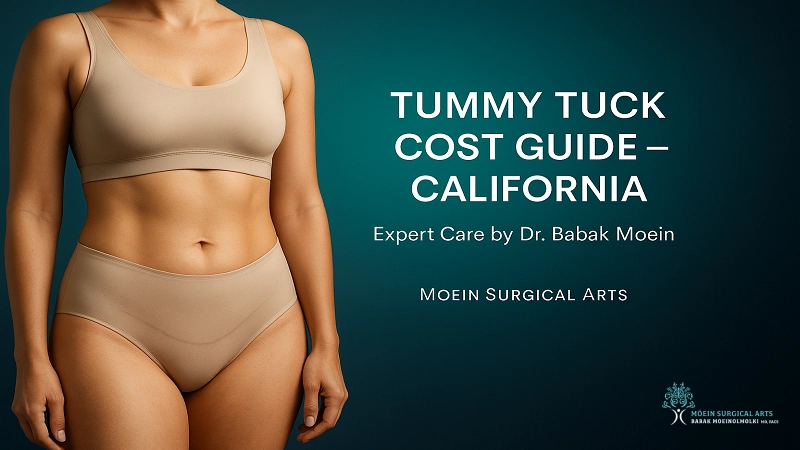
Tummy Tuck Cost in California at a Glance
While every tummy tuck is customized to the patient, most people in California fall into predictable price ranges depending on the type of abdominoplasty they need. The figures below include the surgeon’s fee, accredited operating room, and anesthesia, but do not account for rare special circumstances or non-surgical add-ons.
| Type of Tummy Tuck | Typical Cost Range in California* | Typical Range at Moein Surgical Arts† |
|---|---|---|
| Mini Tummy Tuck Targets loose skin and a small bulge below the belly button. | $6,000 – $10,000 | Most patients invest around $7,500 – $10,500. |
| Standard (Full) Tummy Tuck Removes excess skin and fat, tightens muscles above and below the navel. | $9,000 – $14,000 | Most patients invest around $11,000 – $15,000. |
| Extended Tummy Tuck Addresses abdomen, flanks, and lateral hip or lower back rolls. | $11,000 – $17,000 | Most patients invest around $13,000 – $18,000. |
| Fleur-de-Lis / Post–Weight Loss Tummy Tuck Treats severe horizontal and vertical skin laxity after major weight loss. | $13,000 – $20,000+ | Most patients invest around $15,000 – $22,000+ depending on complexity. |
Estimated ranges for cosmetic abdominoplasty in California; actual quotes vary by city and surgeon experience.
Representative ranges based on typical cases at Moein Surgical Arts; your personalized fee will be confirmed after a comprehensive consultation.
Tummy Tuck Cost by Type of Procedure in California
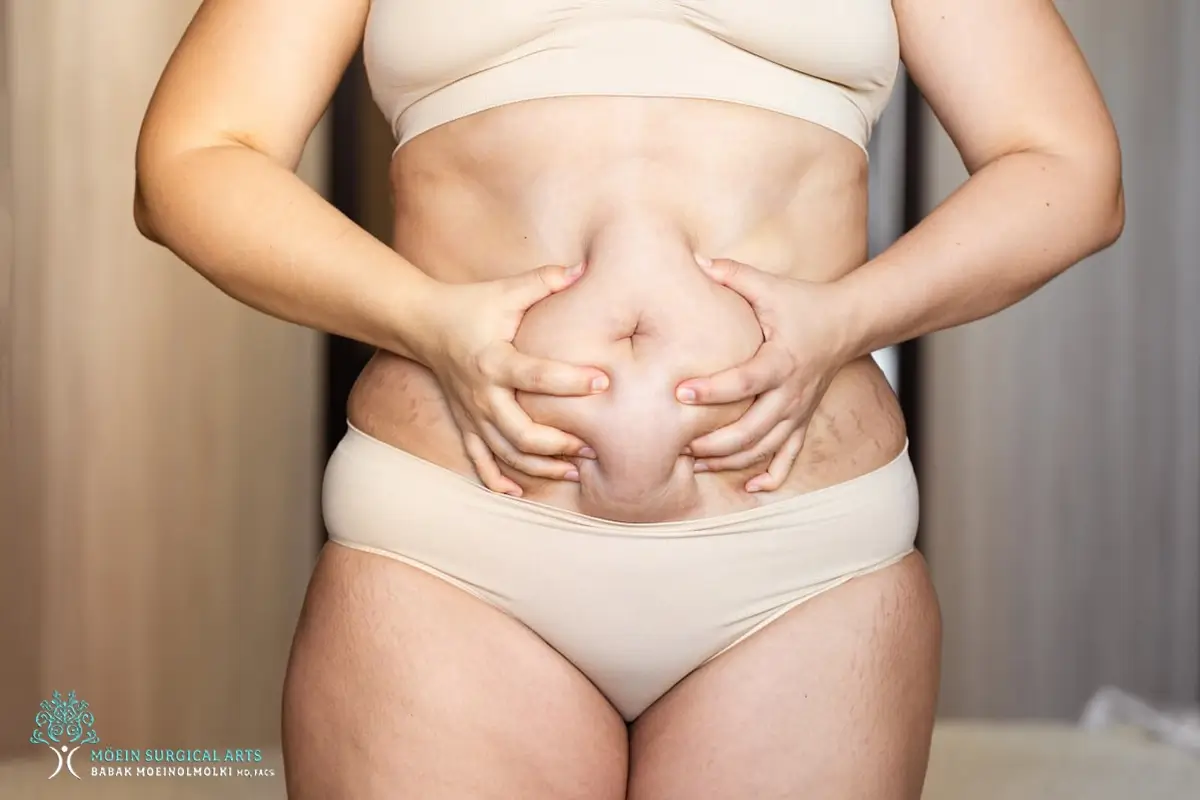
Although every quote is individualized, most patients fall into predictable price ranges based on the type of tummy tuck they need. Understanding these categories will help you compare your options and see why some procedures are more expensive than others.
Mini Tummy Tuck Cost in California
A mini tummy tuck is designed for patients who have a small “pooch” or loose skin limited to the lower abdomen below the belly button. Because the incision is shorter and there is usually no extensive muscle repair, the operation is less complex and takes less time in the operating room.
In California, mini tummy tuck cost typically ranges from $6,000 to $10,000, depending on the surgeon’s experience and whether liposuction is added. At Moein Surgical Arts, most mini tummy tuck patients invest around $7,500 to $10,500, with the exact fee based on your anatomy, skin quality, and need for additional contouring.
Standard (Full) Tummy Tuck Cost in California
A standard, or full, tummy tuck addresses loose skin, excess fat, and muscle separation (diastasis recti) both above and below the belly button. It is the most common type of abdominoplasty for women after pregnancy and for men and women after weight fluctuation. The procedure generally requires a longer incision, more extensive muscle tightening, and more time in the operating room than a mini tummy tuck.
Across California, the cost of a full tummy tuck usually falls between $9,000 and $14,000. In Los Angeles, where facility and staffing expenses are higher, many patients pay toward the upper end of that range. At Moein Surgical Arts, typical investment for a standard tummy tuck is approximately $11,000 to $15,000, including surgeon’s fee, anesthesia, and accredited facility charges.
Extended Tummy Tuck Cost in California
An extended tummy tuck is recommended for patients who have significant laxity not only in the front of the abdomen, but also along the flanks and outer hips. The incision wraps farther around the sides, allowing Dr. Moein to remove a larger apron of skin and fat and to smooth the waistline in three dimensions. Because of the additional contouring and longer incision, extended tummy tucks are more complex and take more time than standard abdominoplasty.
In California, extended tummy tuck cost typically ranges from $11,000 to $17,000. At Moein Surgical Arts, most extended tummy tuck patients invest around $13,000 to $18,000, particularly when flank liposuction or Lipo 360 is performed at the same time to enhance the results.
Fleur-de-Lis and Post–Weight Loss Tummy Tuck Cost in California
For patients who have undergone massive weight loss, skin redundancy can occur both horizontally and vertically. A Fleur-de-Lis tummy tuck (also called an FDL or vertical tummy tuck) uses a low horizontal incision combined with a vertical incision in the midline to remove skin in two directions. This approach is technically demanding, requires meticulous planning, and often involves longer operating times, which is why it is among the higher-cost options.
In California, Fleur-de-Lis and major post–weight loss tummy tucks often range from $13,000 to $20,000 or more, depending on the amount of tissue to be removed and whether procedures such as back or thigh lifts are combined. At Moein Surgical Arts in Los Angeles, most patients considering this level of contouring invest approximately $15,000 to $22,000+, reflecting the complexity of the surgery and the comprehensive aftercare required.
Choosing the Right Procedure for Your Budget and Goals
These ranges are intended as educational guidelines rather than fixed quotes. During your consultation, Dr. Moein will examine your abdomen, clarify whether a mini, standard, extended, or Fleur-de-Lis tummy tuck is most appropriate, and then provide a personalized cost estimate. This allows you to understand both the medical reasoning and the financial implications of each option before you decide how to proceed.
Tummy Tuck Cost in Los Angeles vs the Rest of California
Because Los Angeles is a large, high-demand metropolitan area, tummy tuck prices here are usually higher than in smaller California cities. Facility rent, staffing, and malpractice insurance are all more expensive, and many of the state’s most experienced body-contouring surgeons practice in Los Angeles. As a result, patients often pay a premium in LA but gain access to advanced techniques, high-volume specialists, and fully accredited surgical centers. In mid-size or smaller California markets, costs may be lower, but surgeon experience, technology, and support services can be more variable.
| Region | Typical Tummy Tuck Cost Range* | What Patients Can Expect |
|---|---|---|
| Los Angeles (Moein Surgical Arts) | Approx. $11,000 – $18,000+ | High-volume cosmetic practice, double board-certified surgeon, accredited surgical center, advanced techniques such as Lipo 360 and post–weight loss abdominoplasty. |
| Other Major California Cities (San Diego, Orange County, San Francisco, etc.) | Approx. $9,000 – $16,000 | Experienced surgeons and accredited facilities; costs vary with demand and surgeon reputation. |
| Smaller California Cities | Approx. $8,000 – $14,000 | Lower overhead may reduce price, but surgeon experience, technology, and support services can be more limited. |
Estimated ranges for cosmetic abdominoplasty; individual quotes vary based on procedure type, anatomy, and combined surgeries.
What Factors Influence Your Tummy Tuck Cost in California?
No two tummy tuck patients are identical, which is why prices can vary significantly across California. Your final investment is shaped by a combination of medical, aesthetic, and practical factors that are evaluated during your consultation with Dr. Babak Moein in Los Angeles.
Surgeon’s Training, Expertise, and Case Volume
One of the most important cost drivers is the surgeon you choose. Board-certified surgeons who focus heavily on abdominoplasty and body contouring, and who have a high case volume, typically charge more than less experienced providers. In return, they offer greater safety, refined aesthetic judgment, and more consistent outcomes. As a double board-certified surgeon who has performed thousands of cosmetic and weight-loss procedures, Dr. Moein’s fees reflect his advanced training and the individualized care he delivers.
Type of Tummy Tuck and Time in the Operating Room
The type of tummy tuck you need also plays a major role. A mini tummy tuck, which treats only the lower abdomen, usually takes less operative time than a full or extended tummy tuck that removes more skin, tightens the entire muscle wall, and may address the flanks or lower back. Longer, more complex operations require additional time in the operating room, a larger team, and a longer period under anesthesia—all of which increase the overall cost.
Anesthesia and Accredited Facility Fees
For safety and comfort, tummy tucks are performed under general anesthesia in an accredited surgical facility. Your quote includes the services of a board-certified anesthesiologist and the use of a fully equipped, state-licensed operating room. In high-demand markets such as Los Angeles, facility and staffing expenses are higher than in smaller cities, which is one reason tummy tuck costs in California can sit at the upper end of national averages.
Liposuction and Additional Procedures
Many patients choose to combine their tummy tuck with liposuction, hernia repair, muscle repair, or other body-contouring procedures. While combining operations can be more efficient than staging them separately, each additional procedure adds to the time and resources required. Your fee will reflect whether you need Lipo 360, flank liposuction, a mons lift, or correction of a significant diastasis or hernia in addition to skin removal.
Body Mass Index, Skin Quality, and Surgical Complexity
Your starting anatomy is another key factor. Patients with a higher BMI, poor skin elasticity, or extensive scarring from previous surgeries often require more complex planning and longer operating times. Post–weight-loss patients, including those who benefit from an extended or Fleur-de-Lis tummy tuck, generally fall toward the higher end of the cost spectrum because of the additional incisions and meticulous contouring needed to create a smooth, natural result.
Aftercare, Garments, and Follow-Up Visits
A truly accurate quote should cover more than the day of surgery. At Moein Surgical Arts, your tummy tuck fee also covers high-quality compression garments, standard post-operative medications, and scheduled follow-up visits to monitor your healing. These elements are essential for a safe recovery and long-lasting results, and they are included so you understand the real cost of surgery up front.
During your private consultation, Dr. Moein reviews each of these variables, examines your abdomen, and discusses your goals in detail. This allows him to create a personalized treatment plan and provide a clear, itemized quote for your tummy tuck in Los Angeles, so you can make an informed decision with confidence and no surprises.
Tummy Tuck Variations, Combinations, and Their Impact on Cost
Tummy tucks are not one-size-fits-all. Patients may need a mini, standard, or extended tummy tuck, and some benefit from added procedures such as liposuction, hernia repair, muscle repair, or a mons lift. These choices allow the surgery to be customized to the patient’s anatomy and goals.
However, every added step increases time in the operating room, the size of the team, and use of anesthesia and facility resources. A mini tummy tuck that treats only the lower abdomen is usually faster and less expensive, whereas a full or extended tummy tuck with flank contouring or Lipo 360 is more complex and falls at the higher end of the price range.
Because each combination offers different benefits and costs, patients should review their options in detail with a board-certified surgeon. During consultation, you can determine which technique will best shape the abdomen while staying within a realistic budget.
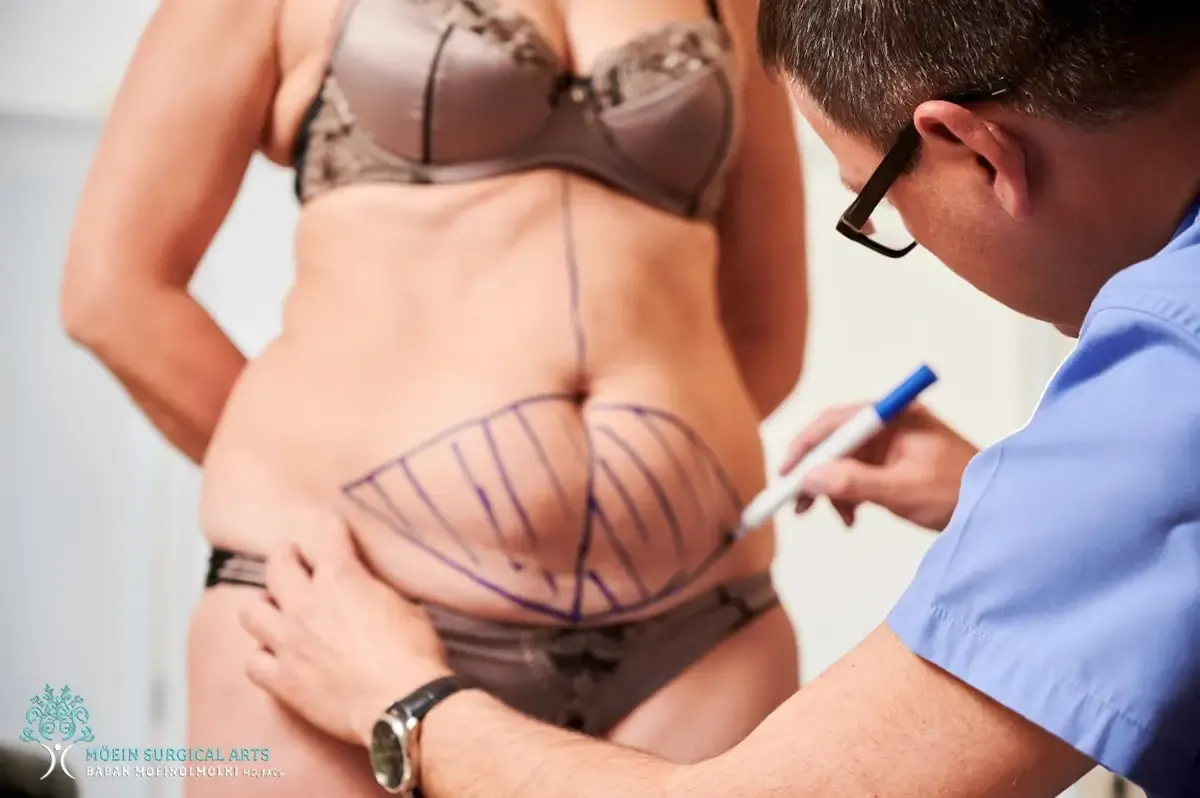
Where can I Get a Professional Tummy Tuck in California
For top-rated tummy tuck surgeons in California, look no further than Dr. Moein.
Dr. Moein and staff are known for their expertise in tummy tuck procedures and their dedication to patient care. They offer personalized treatment plans and prioritize patient comfort and safety. The cost of a tummy tuck at Dr. Moein SurgicalArts varies depending on individual needs and is typically discussed during a consultation.
Conclusion: How much is a tummy tuck in Californra?
According to the latest statistics from the American Society of Cosmetic Surgeons, the average cost of a tummy tuck in California is around $6,253. However, this cost does not include additional expenses such as anesthesia fees, operating room facilities, and other related medical expenses. These additional expenses can add anywhere from $1,500 to $3,000 to the total price.
Several factors can affect the surgeon’s fee for a tummy tuck, including their level of experience and expertise, the geographic location of the practice, the complexity of the procedure, and the specific techniques used. Surgeons who are highly experienced or located in high-demand areas may charge higher fees for their services.
Overall, the average cost of a tummy tuck in California is around $6,253, but additional expenses and the surgeon’s fee can significantly impact the total price. Patients considering this procedure should carefully consider all potential costs and consult with a board-certified Cosmetic Surgeon to fully understand the financial aspects of the tummy tuck process.
]]>When it comes to body contouring, both Liposuction vs Tummy Tuck are popular options for individuals looking to achieve a more toned and defined appearance. Liposuction targets specific areas of stubborn fat, such as the abdomen, thighs, or arms, by removing excess fat deposits through a suctioning process. On the other hand, a tummy tuck, also known as abdominoplasty, focuses on removing excess skin and tightening the abdominal muscles to create a flatter and smoother stomach area.
Ideal candidates for liposuction are generally individuals who are close to their target weight but are struggling with localized pockets of fat that are resistant to diet and exercise. Tummy tuck candidates, however, are usually those who have lost a considerable amount of weight or have excess skin and muscle laxity in the abdominal area, often due to pregnancy or significant weight loss.
Men, in particular, may feel dissatisfied with their bodies due to societal pressures and influences from social media, which highlight the ideal masculine body shape. This can lead to a desire for body contouring procedures to achieve the desired look. It is crucial for individuals to consider their individual needs and goals when choosing between liposuction and tummy tuck to ensure that the right procedure is selected for optimal results.

What Is a Tummy Tuck?
A tummy tuck, also known as abdominoplasty, is a cosmetic surgical procedure used to improve the appearance of the abdomen by removing excess skin and fat and tightening the abdominal muscles.
There are different types of tummy tuck procedures, including the complete tummy tuck, mini tummy tuck, and circumferential abdominoplasty. A complete tummy tuck involves an incision from hip to hip, the removal of excess skin and fat, and the tightening of abdominal muscles. A mini tummy tuck is a less extensive procedure, typically focusing on the area below the belly button. Circumferential abdominoplasty is a more extensive procedure that also includes the removal of excess skin and fat from the back.
The process and recovery expectations for each type of tummy tuck vary, with complete tummy tucks having a longer recovery time than mini tummy tucks. Potential benefits of the procedure include a more toned and slim abdomen, while potential risks include scarring, infection, and complications from anesthesia.
Before considering a tummy tuck, it is important to consult with a board-certified Cosmetic Surgeon to determine the most appropriate procedure based on individual needs and goals.
What Is Liposuction?
Liposuction is a cosmetic surgical procedure that aims to remove excess fat from targeted areas of the body. The procedure involves making small incisions in the skin and using a thin tube, called a cannula, to suction out the fat. Liposuction is typically used to remove fat from areas such as the abdomen, thighs, hips, buttocks, and arms. It is not intended for weight loss, but rather for sculpting and contouring the body.
On the other hand, a tummy tuck, also known as abdominoplasty, is a more extensive surgical procedure that not only removes excess fat but also tightens the abdominal muscles and removes excess skin. The procedure involves making a larger incision along the lower abdomen, repositioning the belly button if necessary, and removing excess skin and fat.
Both liposuction and a tummy tuck have limitations when it comes to major obesity. They are not substitutes for a healthy weight loss program and are best suited for individuals who are close to their ideal body weight. The recovery time for liposuction is typically shorter than that of a tummy tuck, with most patients able to resume normal activities within a few days to a week. A tummy tuck, on the other hand, may require several weeks of recovery and downtime.
Liposuction versus Tummy Tuck: The Comparison
Liposuction and tummy tuck are two popular cosmetic procedures that are often considered for body contouring and fat reduction.
Liposuction is a minimally invasive procedure that targets stubborn pockets of fat and removes them through a suction device. It is ideal for individuals who are close to their ideal weight but have localized areas of fat that won’t respond to diet and exercise. The results of liposuction are generally subtle, with a more sculpted appearance in the treated areas. The recovery time for liposuction is relatively short, with minimal pain and scarring.
On the other hand, a tummy tuck, also known as abdominoplasty, is a more invasive procedure that not only removes excess fat but also tightens the abdominal muscles and removes sagging skin. The results of a tummy tuck are more dramatic, with a flatter and firmer abdomen. However, the recovery time for a tummy tuck is longer, with more discomfort and noticeable scarring.
In terms of procedure invasiveness, recovery times, pain, and scarring, liposuction is generally less invasive with a quicker recovery, less pain, and minimal scarring compared to a tummy tuck. However, tummy tucks typically produce more dramatic results and are more suitable for individuals with significant excess skin and muscle laxity. In terms of cost, tummy tucks are generally more expensive than liposuction due to the complexity of the procedure.

Who Is a Good Candidate for Liposuction vs. Tummy Tuck?
Good candidates for liposuction are individuals who have stubborn pockets of fat that do not respond to diet and exercise. They should be at or near their ideal weight, have good skin elasticity, and be in overall good health. Candidates for a tummy tuck, or abdominoplasty, are typically those who have excess skin, weakened abdominal muscles, and localized fat in the abdominal area. They should also be at a stable weight and in good general health.
It is important for candidates for both procedures to have realistic expectations about the outcomes and to be committed to maintaining a healthy lifestyle after the surgery. Weight loss should ideally be achieved before undergoing these procedures, as they are not a weight loss solution. It is also important to quit smoking, as it can increase the risk of complications and slow down the healing process.
Complicating factors for both procedures include obesity, diabetes, heart disease, and other serious medical conditions. It is important for candidates to thoroughly discuss their health history with a qualified Cosmetic Surgeon to ensure a safe and successful outcome.
Tummy Tuck and Liposuction: Recovery
The recovery process for a tummy tuck and liposuction differs in several ways.
The recovery from a tummy tuck is more extensive than liposuction, as it involves the removal of excess skin and tightening of the abdominal muscles. The expected duration of recovery for a tummy tuck is around 2-4 weeks, whereas for liposuction it is around 1-2 weeks.
After a tummy tuck, patients are usually advised to wear compression garments to minimize swelling and support the abdominal area. In contrast, patients who undergo liposuction may also be required to wear compression garments, but for a shorter period.
Managing discomfort is an important aspect of both recoveries. Pain medication may be prescribed to alleviate any discomfort, but it is generally more intense for a tummy tuck due to the muscle repair involved.
Recommended activities during recovery also vary. Patients may be instructed to avoid strenuous activities for a longer period after a tummy tuck compared to liposuction, which may have a shorter period of restricted activities.
In summary, the recovery process for a tummy tuck is more extensive than liposuction, involving longer recovery duration, the use of compression garments for a longer period, more intense discomfort management, and a longer period of restricted activities.
What Results Can I Expect?
When starting any new endeavor or embarking on a new journey, it’s natural to wonder what kind of results you can expect. Whether it’s a fitness program, a new job, or a new hobby, understanding what you can hope to achieve is an important part of setting realistic goals and expectations. In the following headings, we will explore the potential outcomes and results that you can expect when starting something new, providing insight and realistic information to help you on your path to success.
Tummy Tuck Results
If you are considering a tummy tuck procedure, the potential results include a smoother and firmer abdominal profile, as excess skin and fat are removed. While there will be a visible horizontal scar initially, it typically fades over time. Patients also often experience improved confidence in clothing and swimwear.
It’s important to note that the results of a tummy tuck differ from those of liposuction. A tummy tuck focuses on the permanent removal of excess skin and fat tissue, resulting in a tighter and flatter abdomen, while liposuction targets specific areas of fat but does not address loose skin.
Weight gain and future pregnancies can impact the long-term results of both procedures. Significant weight gain after a tummy tuck can affect the firmness of the abdomen, while subsequent pregnancies can stretch the skin and muscles, potentially reversing the results of the surgery. It’s recommended for patients to be at a stable weight and have completed their family planning before undergoing a tummy tuck to maximize long-term results.
Liposuction Results
Liposuction is a long-lasting solution for body contouring, targeting stubborn fat deposits in areas such as the abdomen, thighs, and arms. The procedure involves removing excess fat cells through a suction technique, resulting in a more sculpted and defined appearance.
In comparison, a tummy tuck focuses on removing excess skin and tightening the abdominal muscles, resulting in a flatter and firmer abdomen.
The recovery process for liposuction typically involves mild discomfort, bruising, and swelling, with most patients able to return to work within a few days and resume exercise within a few weeks.
When considering which procedure is suitable, it’s essential to evaluate the amount of excess fat and skin in the targeted area. Liposuction is ideal for those with localized fat deposits, while a tummy tuck may be more suitable for those with excess skin and muscle laxity.
Potential side effects of liposuction include temporary numbness, uneven contours, or fluid accumulation, but these are usually rare and improve with time. The recovery period varies for each individual, but most individuals can expect to see final results within six months to a year. Overall, liposuction offers long-lasting body contouring benefits with minimal downtime.
Tummy Tuck, Liposuction, or Both?
Tummy tuck, also known as abdominoplasty, is a surgical procedure that removes excess skin and fat from the abdominal area and tightens the abdominal muscles. This is a good option for individuals who have sagging skin or weakened muscles due to weight loss, pregnancy, or aging. Candidates for a tummy tuck should be in good overall health, have realistic expectations, and be at a stable weight.
Liposuction, on the other hand, is a minimally invasive procedure that targets specific areas of stubborn fat deposits in the body. This is a good option for individuals who have localized areas of fat that are resistant to diet and exercise. Candidates for liposuction should be within their ideal weight range, have good skin elasticity, and be in good overall health.
A combination of both procedures can be suitable for individuals who have both excess skin and stubborn fat deposits in the abdominal area. This approach can provide comprehensive improvement in the overall appearance of the midsection. Candidates for a combination procedure should meet the qualifications for both tummy tuck and liposuction and should consult with a qualified Cosmetic Surgeon to determine the best approach for their individual needs.
Before scheduling any surgical procedure, individuals should carefully consider the potential risks, recovery time, and long-term commitment to maintaining a healthy lifestyle. It is important to consult with a board-certified Cosmetic Surgeon to discuss the best options and expected outcomes.
Conclusion: Liposuction vs Tummy Tuck: Best for Body Contouring
In conclusion, the key differences between liposuction vs tummy tuck procedures lie in the areas of the body they target and the outcomes they achieve. Liposuction primarily targets and removes excess fat from specific areas of the body, while a tummy tuck focuses on removing excess skin and tightening the abdominal muscles.
The combination of liposuction and tummy tuck can be beneficial for individuals seeking comprehensive body contouring results. This combination can address both excess fat and skin, resulting in a more sculpted and toned appearance.
Before and after pictures can effectively illustrate the results of each procedure. Liposuction may show a reduction in localized fat deposits, while a tummy tuck can demonstrate a smoother and more contoured abdomen.
Ultimately, the choice between liposuction and tummy tuck depends on the specific concerns and goals of the individual. Consulting with a qualified Cosmetic Surgeon is crucial in determining the most suitable approach for achieving desired body contouring results.
]]>Introduction: Resume exercise after Tummy Tuck
You’ve finally undergone a tummy tuck and appreciate a toned, flat belly. However, you may wonder, “When can I start exercising again and what exercises are safe after Tummy Tuck Surgery?”.The tummy tuck is a popular cosmetic surgery that promises to give you shapelier curves and a flatter tummy in a single surgical session. Patients often choose a tummy tuck after significant weight loss, where there is still some belly fat left behind and a bit of abdominal skin sagging. Women also choose this ab-shaping procedure following childbirth and breastfeeding, which can help return their mid-sections to pre-pregnancy conditions.
Many people want a tummy tuck after they have become aware of how their body looks, particularly in a bathing suit or in the nude. The belly area can be particularly frustrating because even strict dieting and arduous physical activity can fail to remove the last few pounds from the abdominal area. A tummy tuck can help these concerns.
However, some people hold back on signing up for a tummy tuck. Why? They fear being ‘down for the count’ for an extended period of time during tummy tuck recovery. What if they overeat while they cannot move their bodies? Won’t the tummy tuck results become undone? Why spend all that money if you can’t exercise like you normally would to keep the excess pounds at bay?
If these thoughts have ever crossed your mind, you’re in good company. A common question cosmetic surgeons often get is:
“I want to stay fit after my tummy tuck. When can I exercise again?”
To answer that question, it helps to understand what takes place during tummy tuck surgery, the importance of the recovery period afterward, and how it is still possible to retain your results even as you rest. And believe it or not, your absence from exercise after a tummy tuck will not last that long. You will be back to your normal routine before you know it, looking better than ever, we might add. If you have wondered “When can I start doing squats after tummy tuck? When can I start running after tummy tuck? or when can I exercise after tummy tuck?” then this blog was written for you.
Why Do Men and Women Choose Tummy Tuck Surgery?

In addition to removing excess fat and saggy skin, the tummy tuck tightens and strengthens your abdominal muscles. This is important for mothers to know if they are considering a tummy tuck. The abdominal muscles can become weakened during childbirth. The tummy tuck can give you a tighter midsection, improve control over your abdominal muscles, and help with involuntary incontinence, not to mention back pain.
Here is something else mothers considering the tummy tuck may not know. Stretch marks can be removed using the procedure, but only if they appear within the area where excess skin will be removed.
For all others, the tummy tuck takes around two to four hours, and when you wake up, you will have noticeably slimmer abdominal contours and a flatter belly. Some swelling may occur after the surgery but will subside, allowing the true results of the procedure to shine through in a matter of weeks.
“What Can I Expect During TummyTuck (Abdominoplasty) Surgery?”
The medical term for a tummy tuck is abdominoplasty, the surgical removal of excess fatty tissue and skin from the abdomen. Tummy tuck surgery is often used as a component of mommy makeover surgery, which allows women to transform their bodies with multiple surgeries in one session. Examples of mommy makeover procedures include breast augmentation, tummy tuck, liposuction, and Renuvion for added skin tightening.
The surgery can also be used, sometimes along with liposuction, to make your abdominal section appear more youthful and attractive.
The surgery begins with the anesthesiologist placing you under general anesthesia. You will not be awake during the procedure, so you will not feel a thing, nor will you remember anything about the surgery after you wake up in the recovery area.
Once you are under anesthesia, the cosmetic surgeon creates an incision along the lower portion of the abdomen. The incisional line runs above your pubic bone and extends to your hips.
It should be noted that there are different types of tummy tucks, including mini and full tummy tucks, which require different incision lengths. The procedure we’re describing is a full tummy tuck.
Liposuction
It is at this stage that liposuction can be used. You can also opt for High-Definition Liposuction (HD-Lipo) for even deeper abdominal etching. The liposuction procedure gently suctions the fat out of the abdominal area. Imagine all those hours of dieting and exercising; a machine can do the work in minutes. But this rapid fat removal is what makes the tummy tuck so popular.
Once the fat is sufficiently removed, the surgeon pulls the abdominal muscles tight and reattaches them to fortify the abdominal wall. The belly button may be repositioned for natural placement and to add symmetry to your newly shaped curves.
Excess skin can be removed from the abdominal area before the skin is tightened and sutured.
After surgery, you will find yourself in a recovery staging area when you open your eyes. The nursing staff monitors your vital signs closely to ensure your wellness and safety as you briefly recover from your successful tummy tuck surgery.
Read our article: IS TUMMY TUCK SCARRING A NECESSARY ASPECT OF COSMETIC SURGERY? HOW TO MINIMIZE ABDOMINOPLASTY SCARS
Is a Tummy Tuck Procedure Painful?
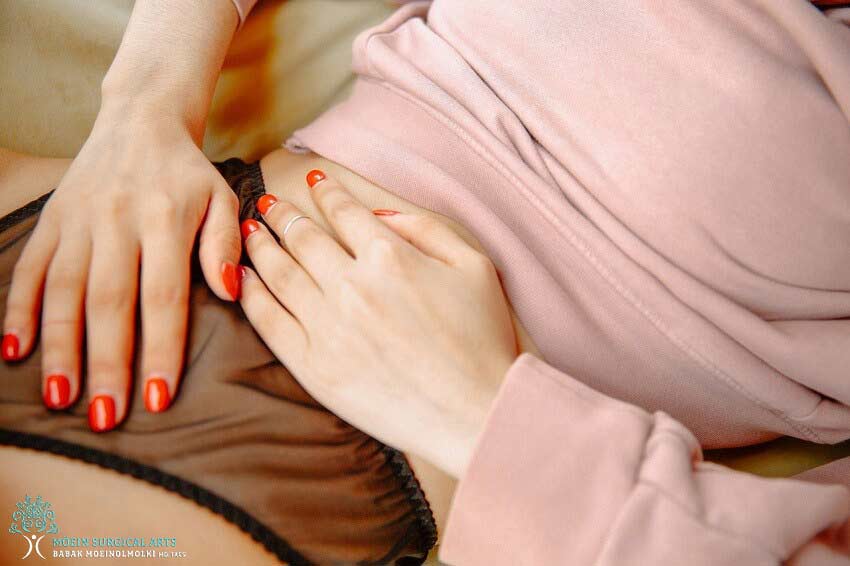
You don’t notice how much you use your abdominal muscles for every movement until they are sore from tummy tuck surgery. Following the abdominoplasty procedure, you may feel soreness and tenderness around the abdominal area. This is part of the healing process.
While you do feel soreness, you mustn’t exercise. Not only would working out be uncomfortable for you as you heal from a tummy tuck, but any strain you put on the area could cause damage to your hard-earned results.
But what about exercise after a tummy tuck? Finally, the part you came for.
Timeline from Tummy Tuck Surgery to Exercise
Day of Surgery
Patients typically remain in the recovery area of the surgical center for up to 24 hours after the tummy tuck is completed. You are then released to a trusted friend or family member. Your surgeon gives you post-operative instructions to follow, so you can comfortably rest at home.
The information given by your surgeon includes care tips for incision wounds, ways to prevent swelling, and infection prevention advice.
As you settle in at home, you could find it difficult to sit up or stand without assistance. This is a normal experience during recovery. Your ability to sit and stand unassisted should improve day by day.
Your surgeon gives you a compression garment for four to six weeks. This prosthetic device provides adequate pressure to the surgical site to aid blood circulation. This, in turn, helps speed the healing process while also preserving your results as the wounds from surgery close.
Week One
As you recover, you may start feeling more yourself after the first week. It is important to refrain from exercising, even if you feel like a low-impact workout will help scratch that itch.
Your surgical incisions are still healing, and you could still feel pain or discomfort as a result. There might also be swelling and post-op fatigue.
Take it easy. Your results will be better for it, and this time will pass quickly, at least in hindsight. Your exercise timeline after tummy tuck will be more clear over the next few weeks.
Two Weeks After Tummy Tuck Surgery
Fourteen days have passed since your tummy tuck surgery. Your doctor has already cleared you to return to work, depending on how you make your living. A desk job is easier on a post-tummy tuck patient than a job that has you on your feet all day. Construction and other labor-intensive jobs may require longer recovery times before you are cleared to return for duty.
You may think exercise might be okay since you’ll be back at work. Try to go a little longer without exercising. Your core muscles should not be subjected to strain at this time. You will have to wait just a little bit longer to begin exercises after a tummy tuck surgical procedure.
Rest and Recovery Week Three and Four

By week three, you begin to rejoice. Your surgeon has cleared you for light exercise after a tummy tuck. You should continue working out lightly for at least four weeks post-operation. The tummy tuck leaves your abdominal muscles stronger, but only if the surgical wounds heal properly. It would help if you avoided ab-heavy exercises like sit-ups, crunches, planks, squats, lunges, and weightlifting.
By light exercises, your surgeon means walking and easy biking. This is when your exercise timeline after tummy tuck will become more clarified.
Six Weeks Following Your Tummy Tuck Procedure
By week six, you will be back in the weight room if that’s your preferred way to work out. That’s right! You will return to your regular exercise routine by the sixth week, though you should still be vigilant. Be aware of signs that you are pushing your body too far or working your abdominal muscles past the point of comfort.
Start slowly and work your way back up to the monster routine you were accustomed to before tummy tuck surgery. Since normal exercise routines vary, you must trust yourself when enough feels like enough. Talk to your surgeon for details about your specific case. If you have been wondering, “When can I start doing squats after tummy tuck?” you are almost there. Gentle running after tummy tuck is now a reality.
What About Working Out (In the Bedroom)?
Waiting six weeks to lift weight and even squats is now feasible. Are you also supposed to refrain from getting sweaty between the sheets? No, after six to eight weeks, your restrictions are now lifted!
You should never be embarrassed to talk to your surgeon about when it is safe to resume sex after a tummy tuck. Your surgeon will recommend you wait at least two weeks following a tummy tuck. Go easy, and let your partner do all the heavy lifting.
Don’t Forget About Sleep

Sleeping at night helps with tummy tuck recovery and gives you better results following exercise. Immediately after your procedure, within the first week, try not to sleep on your stomach. Only sleep prone if your abdominal muscles no longer feel sore.
Many tummy tuck patients find sleeping with pillows propped up underneath their knees and head helps to reduce discomfort. This position, known as the semi-Fowler’s position, can be used for up to two weeks after surgery to avoid straining the surgical area. A recliner also works.
Conclusion: resume exercise after tummy tuck
By now, you are well-versed on what to expect from tummy tuck surgery. You are also more aware of how long you must wait before you can resume strenuous activities like spinning, CrossFit, and heavy lifting.
Six weeks is usually the time to go from the tummy tuck to your regularly scheduled exercise routine. Although, you could be back to light exercise four weeks after tummy tuck surgery. That’s nothing!
To make the recovery process go by faster, list fitness goals you want to accomplish once you are cleared for regular workouts. Take the time to watch videos and study your routine so you know how to proceed once your surgical area has healed. By then, you’ll be able to engage in light, strenuous, and cardiovascular exercises to your heart’s content. A killer routine might transform your physique now that you’ve done your part to attain a flatter, more youthful belly with tummy tuck surgery.
Ready to Experience a Slimmer You?
Moein Surgical Arts is a state-of-the-art surgical center in Los Angeles, California. Using tools and decades of experience, Dr. Babak Moein and his professional staff warmly welcome you. We encourage you to call us to schedule a consultation with Dr. Moein.
SCHEDULE A CONSULTATION 310 455-8020
Read More
]]>The decision to undergo abdominoplasty, commonly known as a tummy tuck, can be life-altering…
In fact, the impact of this surgical procedure extends far beyond physical transformation. It’s about reclaiming one’s body and self-confidence.
We’ve gathered some compelling stories from real patients who have experienced these transformations firsthand through Transforming Lives with Abdominoplasty: Real Patient Stories.
The Rising Trend of Tummy Tuck Surgery Among African-American Women
Plastic surgery, particularly tummy tucks or abdominoplasty procedures, has seen a significant uptick among black women in recent years. These surgeries offer the promise of enhanced body contours and boosted self-confidence.
A noteworthy observation is that while more black women embrace plastic surgery, they often prefer less extreme surgical changes. The goal? To preserve their ethnic features while enhancing certain aspects of their appearance. Dr. Babak Moein, a board-certified cosmetic surgeon with extensive practice experience, confirms this trend.
A board-certified Cosmetic Surgeon with extensive practice experience, Dr. Babak Moein confirms that body procedures such as liposuction, fat grafting and breast augmentation are the most sought-after treatments by black women today; however, unique challenges do exist post-surgery like developing keloid scars after liposuction due to higher collagen production in darker skin tones. However, unique challenges do exist post-surgery like developing keloid scars after liposuction due to higher collagen production in darker skin tones.
Statistics Reflecting The Rising Trend
Diving into statistics uncovers an interesting pattern in cosmetic trends among African American women over the past decade – demand for body contouring procedures like tummy tucks has significantly increased during this period. Understanding these trends thoroughly can help prospective patients make informed decisions regarding treatment plans whereas medical professionals can strategize patient care accordingly.
Risks And Considerations For Black Women Seeking Plastic Surgery
All forms of plastic surgery come with potential risks that need careful consideration before proceeding. This holds especially true for black women who may be prone to complications such as poor scarring or hyperpigmentation following invasive operations, including liposuction or abdominoplasty procedures.
Personal Stories: Transformative Effects of Abdominoplasty
The path to achieving a sculpted and firm abdomen is deeply personal, with every individual having their own unique journey. The transformative power of tummy tuck surgery extends beyond the physical aspect—it has profound effects on self-esteem and overall life quality.
Bianka Fort’s Tummy Tuck Story
In her quest for improved body contour while preserving her natural curves, Bianka Fort embarked on an abdominoplasty journey. After thorough research and consultations with board-certified Cosmetic Surgeons, she decided that liposuction combined with a tummy tuck was the best course for her.
The results were nothing short of breathtaking, Bianka reported feeling more confident in herself post-surgery. She loved how the procedure enhanced her waistline without compromising the voluptuousness she cherished about herself—a perfect example of black women seeking plastic surgery but wanting less extreme surgical changes.
A Mother’s Life-Changing Postpartum Tummy Tuck
Another compelling story involves a mother who had given birth to twins. Following childbirth, multiple hernias plagued this brave woman along with severe diastasis recti – where stomach muscles separate due to pregnancy or obesity—and left her lower abdomen significantly protruding even after losing baby weight.
Faced daily discomfort coupled by self-consciousness regarding appearance around belly button area led this courageous lady towards abdominal wall-reconstruction surgery immediately following consultation for a pre-planned tummy-tucks procedure. American Society for Cosmetic Surgeons suggests such cases are not uncommon among women post-childbirth looking forward to restoring their bodies back into shape through reconstructive surgeon intervention.
Understanding the Procedure – From Consultation to Recovery
A journey towards a successful tummy tuck surgery begins with an in-depth consultation. This is where patients meet their chosen Cosmetic Surgeon, discussing expectations, health history, and potential risks associated with abdominoplasty.
In preparation for this body procedure, specific instructions about diet modifications, medication adjustments if needed are given by Cosmetic Surgeons. For smokers? Quitting becomes essential during this preoperative period as it significantly impacts surgical outcomes.
The Day of Operation: Undergoing Abdominoplasty
The actual operation takes place under general anesthesia; reshaping the lower abdomen involves removing excess skin and fat while tightening loose stomach muscles caused by factors such as pregnancy or weight loss.
- Excess Skin Removal – The primary goal here is achieving a flatter belly profile through the removal of sagging skin folds which often result from drastic weight changes or giving birth.
- Fat Elimination – Stubborn pockets of fat resistant to dieting efforts can be effectively addressed via liposuction incorporated into the tummy tuck process.
- Muscle Tightening – Separated abdominal muscles (called diastasis recti) due to pregnancies get tightened up restoring a firmer abdominal wall structure post-surgery.
Navigating Post-Surgery: Recovery & Complications
Recovery time varies among individuals but generally requires several weeks of rest along with limited physical activity after undergoing abdominoplasty.
Potential complications like poor scarring or occurrence called diastasis recti need monitoring closely during the recovery phase.
Your communication lines should always remain open between yourself and your reconstructive surgeon so any arising concerns can be promptly tackled.
Expert Insights from Top Cosmetic Surgeons
The world of abdominoplasty is as diverse and unique as the patients seeking Cosmetic Surgeons for this transformative procedure. Let’s delve into what top-notch, board-certified professionals like Dr. Moein, a prominent Los Angeles-based cosmetic surgeon, have to say about tummy tuck surgery.
These insights emphasize that every journey towards a flatter stomach through abdominoplasty requires an individualized approach shaped by careful consideration of multiple elements.
Navigating Health Status Prior to Surgery
Patient health isn’t just another box on the checklist; it’s pivotal in shaping surgical strategies for procedures like abdominal wall-reconstruction surgery immediately after giving birth or addressing diastasis recti post-pregnancy.
Maintaining weight stability prior to undergoing extreme surgical body procedures can greatly influence healing processes along with final aesthetic outcomes.
Achieving Desired Results While Minimizing Risks
Striking a balance between achieving desirable aesthetics while mitigating complications is where art meets science in cosmetic surgeries including tummy tucks.
This delicate equilibrium stems from detailed preoperative consultations where expectations are thoroughly discussed alongside possible side effects – all aimed at delivering satisfactory lower abdomen transformations without compromising safety standards.
The Importance Of Board Certification In Cosmetic Surgeries
Certification matters. Especially when you’re trusting someone with your transformation story via complex body procedures ranging from breast augmentation fat grafting up until more extensive ones like belly button reshaping during Tummy Tuck Surgery.
Board certification ensures adherence not only to technical proficiency but also ethical conduct – critical aspects ensuring best care possible throughout your journey towards enhanced self-confidence.
Enhancing Self-Confidence with Abdominoplasty
In cosmetic surgery, abdominoplasty or tummy tuck surgery is not just about physical transformation. It’s a journey towards improved self-confidence and an enhanced outlook on life.
This sentiment echoes across countless patients undergoing this transformative procedure at Moein Surgical Arts.
Tummy Tucks as Motivation for Healthier Lifestyles
The benefits extend beyond what meets the eye – it’s more than simply having a flat belly post-surgery. Many individuals find themselves inspired to maintain healthier lifestyles after seeing their new bodies following their procedures.
- Achieving desired results motivates consistent exercise routines (reported by 55% of our patients).
- Dietary habits improve significantly due to increased body consciousness (as per feedback from 45% of clients).
Abdominal Wall-Reconstruction Surgery Immediately Fuels Positive Change
Motivational Factors:
- Improved Body Image: When you love how you look, it reflects positively on your overall well-being.
- Increased Physical Comfort: Eliminating excess fat and loose skin makes daily activities easier.
- Enhanced Wardrobe Choices: A slimmer profile expands clothing options, allowing people to dress confidently.
Research supports these claims, indicating higher levels of satisfaction among those who undergo such body contouring procedures compared to those who do not.
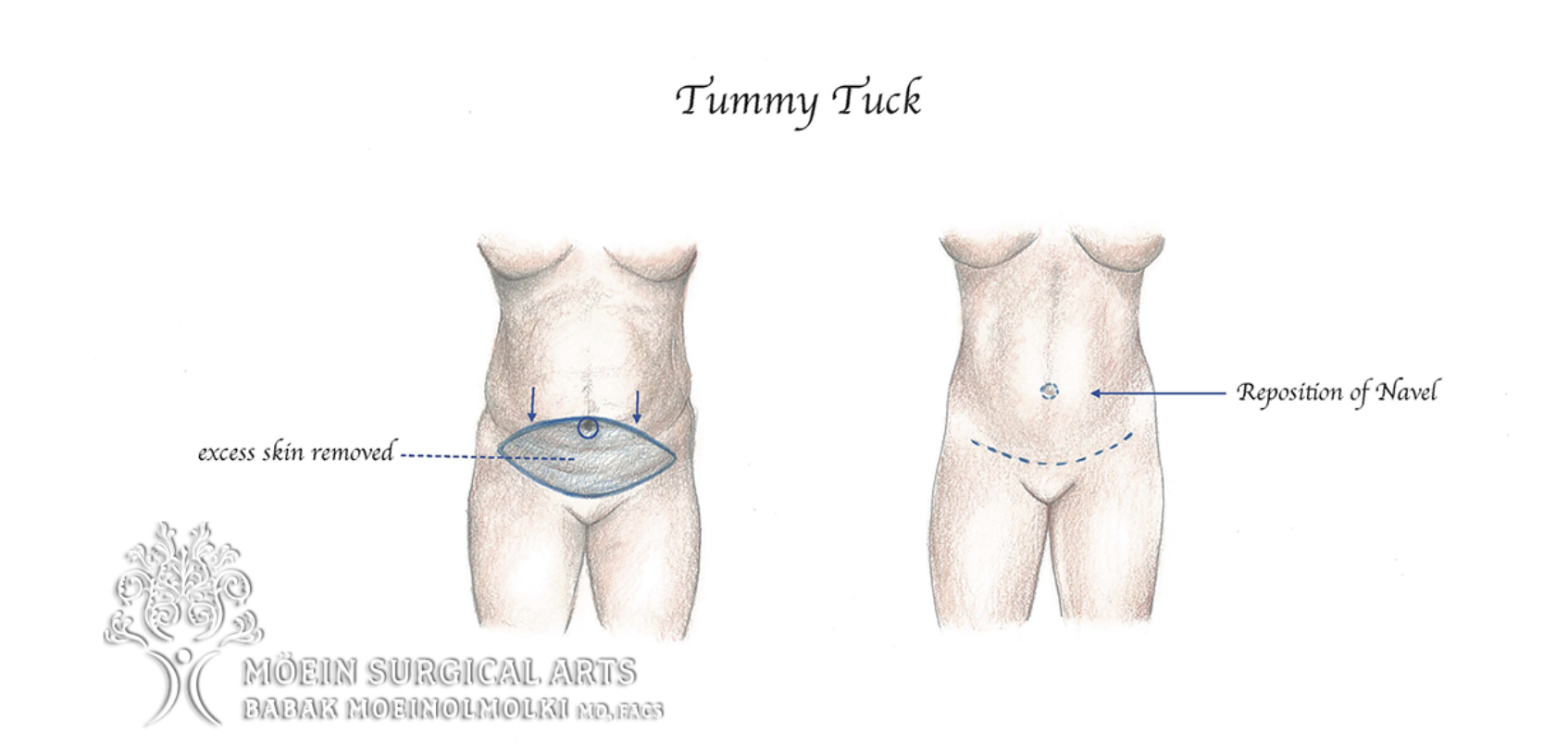
Debunking Myths About Tummy Tucks
Many misconceptions exist regarding abdominoplasty, or “tummy tuck” surgery as it’s more popularly known. The most prevalent myths? That this procedure serves purely cosmetic purposes and is exclusive to women post-childbirth.
In reality, while many patients do seek a tummy tuck prior to significant life events like weddings or after giving birth for an improved appearance, its benefits aren’t just skin deep.
Tummy Tucks: Not Just Cosmetic
This surgical intervention can also be medically necessary in certain cases. For instance?
- A severe hernia may require reconstructive surgeon expertise alongside a Cosmetic Surgeon for abdominal wall reconstruction surgery immediately following the initial operation.
- Muscle separation (also called diastasis recti) might necessitate medical intervention through similar procedures to restore functionality and strength back into one’s lower abdomen area around the belly button region.
Tummy Tucks Aren’t Exclusive To Women Post-Childbirth
Debunking Myths About Tummy Tucks
There are numerous misconceptions surrounding this transformative body procedure.
The truth of the matter? It’s time to debunk these myths and shed light on what a tummy tuck really entails.
Tummy Tucks: Not Just for Postpartum Women
A common belief is that only women who have given birth can benefit from a tummy-tuck operation. Yes, many mothers do opt for this plastic surgery after childbirth to tighten their stomach muscles and eliminate excess skin around the lower abdomen area. But here’s where it gets interesting:
Research, however, provides valuable insights about how men too can reap benefits from such procedures as part of body contouring strategies or following significant weight loss.
Necessity Beyond Cosmetics: Medical Cases
Another myth suggests that an abdominoplasty serves purely aesthetic purposes – nothing could be further from reality.
In fact, there exist medical conditions necessitating an immediate abdominal wall-reconstruction surgery post traditional tummy-tuck operation.
Cases involving severe hernias or extreme muscle separation known as diastasis recti may require such dual approach surgeries ensuring optimal health outcomes while improving physical appearance simultaneously.
Expert Insights from Top Plastic and Cosmetic Surgeons
Tummy tuck surgery is a transformative procedure that requires an individualized approach.
A highly experienced cosmetic surgeon helps us understand how each patient’s health status, desired results, and potential risks are carefully considered before proceeding with abdominoplasty.
Dr. Babak Moein, A Specialist’s Take on Tummy Tucks
Los Angeles-based cosmetic surgeon Babak Moein shares his unique perspective on performing successful tummy tucks. According to Dr. Moein, it isn’t just about removing excess skin or fat; tightening stomach muscles plays a crucial role too for achieving a more toned appearance.
He emphasizes educating patients about what they can realistically expect post-surgery – stressing that while abdominoplasty significantly improves one’s silhouette, it should not be viewed as an alternative to weight loss or healthy living habits.
Risks Associated With Abdominal Wall-Reconstruction Surgery Immediately Post-Tummy Tuck
No surgical procedure comes without its set of potential complications and risks – including poor scarring after undergoing abdominal wall-reconstruction surgery immediately following your tummy-tuck operation.
Certain factors such as genetic predisposition towards poor wound healing or lifestyle choices like smoking may impair the recovery process after any extreme surgical procedures involving the abdomen area.
These considerations make pre-operative counseling regarding scar management strategies an extremely important part of consultation prior to any major body procedures, including lower abdomen surgeries like abdominoplasties.
Expert Insights from Top Cosmetic Surgeons
In the realm of cosmetic surgery, abdominoplasty or tummy tuck surgery stands out as a transformative procedure. Who better to shed light on this than board-certified Cosmetic Surgeons themselves? Let’s delve into what Dr. Moein, an esteemed cosmetic surgeon has to say:
To put it simply, individuality matters when planning for procedures like abdominoplasty.
Personalized Surgical Approach
The concept of ‘one-size-fits-all’ doesn’t hold water in abdominal wall-reconstruction surgeries immediately following a tummy tuck prior operation. It requires careful consideration and customization based on each patient’s needs.
- For some patients with excess skin or fat primarily located around their lower abdomen area,
- A different approach may be required for those dealing with conditions such as called diastasis recti post-pregnancy or significant weight loss,
- This necessitates highly personalized surgical strategies formed after thorough consultations and examinations before proceeding with the procedure.
Risks Associated With Abdominoplasty
Every medical intervention carries inherent risks – poor scarring due to general anesthesia used during extreme surgical procedures being one among them.
A competent surgeon will ensure that these potential hazards are discussed openly during pre-operative discussions so that patients can make informed decisions about embarking upon their journey towards body transformation through abdominoplasties.
Remember, knowledge is power especially when you’re considering going under the knife.
Expert Insights from Top A Top LA Surgeon
But what makes this surgical intervention so appealing? LA-based cosmetic surgeon Babak Moein renowned for his expertise in body procedures including abdominoplasty, offers some insights:
This essentially means that each case requires an individualized approach considering various factors such as the person’s anatomy and personal goals.
Patient-Centered Approach in Abdominoplasty
A successful tummy tuck isn’t just about creating aesthetic changes; it involves enhancing patients’ quality of life by addressing specific concerns like poor scarring or called diastasis recti post-surgery.
To achieve optimal outcomes, surgeons must adopt a collaborative process where they actively involve patients in decision-making processes regarding their care – ensuring both parties have realistic expectations on achievable results through surgery while minimizing potential complications.
Risks Associated With Tummy Tucks
Abdominal wall-reconstruction surgeries aren’t without risk either – these include issues with anesthesia during operation among others which should be openly discussed between prospective patients seeking Cosmetic Surgeons prior deciding if undergoing this transformative body procedure is right for them.
Making informed decisions can lead to better outcomes boosting self-confidence after recovery – one major reason why many seek out this type of cosmetic intervention.
FAQs in Relation to Transforming Lives With Abdominoplasty: Real Patient Stories
Does anyone regret tummy tuck?
While most patients are satisfied, some may experience post-surgery complications or unmet expectations. Thorough research and choosing a reputable surgeon can mitigate these risks.
Are most people happy after tummy tuck?
A majority of patients report increased self-esteem and body confidence following abdominoplasty, according to the American Society for Cosmetic Surgeons.
What is the downfall of a tummy tuck?
Potential downsides include surgical risks, lengthy recovery period, possible scarring, and cost as it’s typically not covered by insurance unless medically necessary.
What are the long-term problems after a tummy tuck?
Rare long-term issues can include poor wound healing leading to visible scars, numbness in lower abdomen area or changes in skin sensation.
Conclusion
- Abdominoplasty, or the tummy tuck procedure, is more than a cosmetic surgery.
- It’s an empowering journey that transforms lives in ways you may not have imagined before reading Transforming Lives with Abdominoplasty: Real Patient Stories.
- We’ve delved into the rising trend among African-American women and shared real-life stories of those who underwent this life-changing procedure.
- You now understand what to expect from consultation to recovery and gainm insights from top surgeons on how they approach each case individually.
- We’ve also debunked common myths about abdominoplasty and highlighted its role in enhancing self-confidence by improving appearance motivating individuals towards healthier lifestyles post-surgery.
f you’re ready for your own transformation story through abdominoplasty, consider reaching out to Moein Surgical Arts.
Their expert team will guide you every step of the way, ensuring your comfort and satisfaction while helping you achieve the body confidence you deserve. It’s time for your new chapter – let Moein Surgical Arts help turn it into reality!
]]>Truth be told, many people believe that once they’ve undergone the knife, maintaining their new physique will be a walk in the park. This is far from accurate.
In fact, without proper fitness and nutrition post-surgery, your tummy tuck results could diminish over time.

The Importance of BMI in Tummy Tuck Surgery
BMI is a critical factor to consider when undergoing tummy tuck surgery, as it provides an indication of body fat levels. This number, a ratio calculated by dividing your weight in kilograms by the square height in meters, serves as an important indicator of body fat.
If you’re considering abdominoplasty or any form of plastic surgery, having a healthy BMI, ideally below 30, is highly recommended. But why does this matter?
A healthy BMI can significantly enhance your tummy tuck results. Patients with lower BMIs usually have less visceral fat – deep-seated abdominal fats surrounding internal organs – making it easier for surgeons to achieve optimal outcomes during body contouring surgeries like a tummy tuck.
Beyond aesthetics, though, there are also safety considerations at play here. Higher BMIs are associated with greater risk factors such as poor wound healing and increased chance of infection post-surgery; hence, many surgeons refrain from operating on patients whose BMI exceeds 40 unless medically necessary.
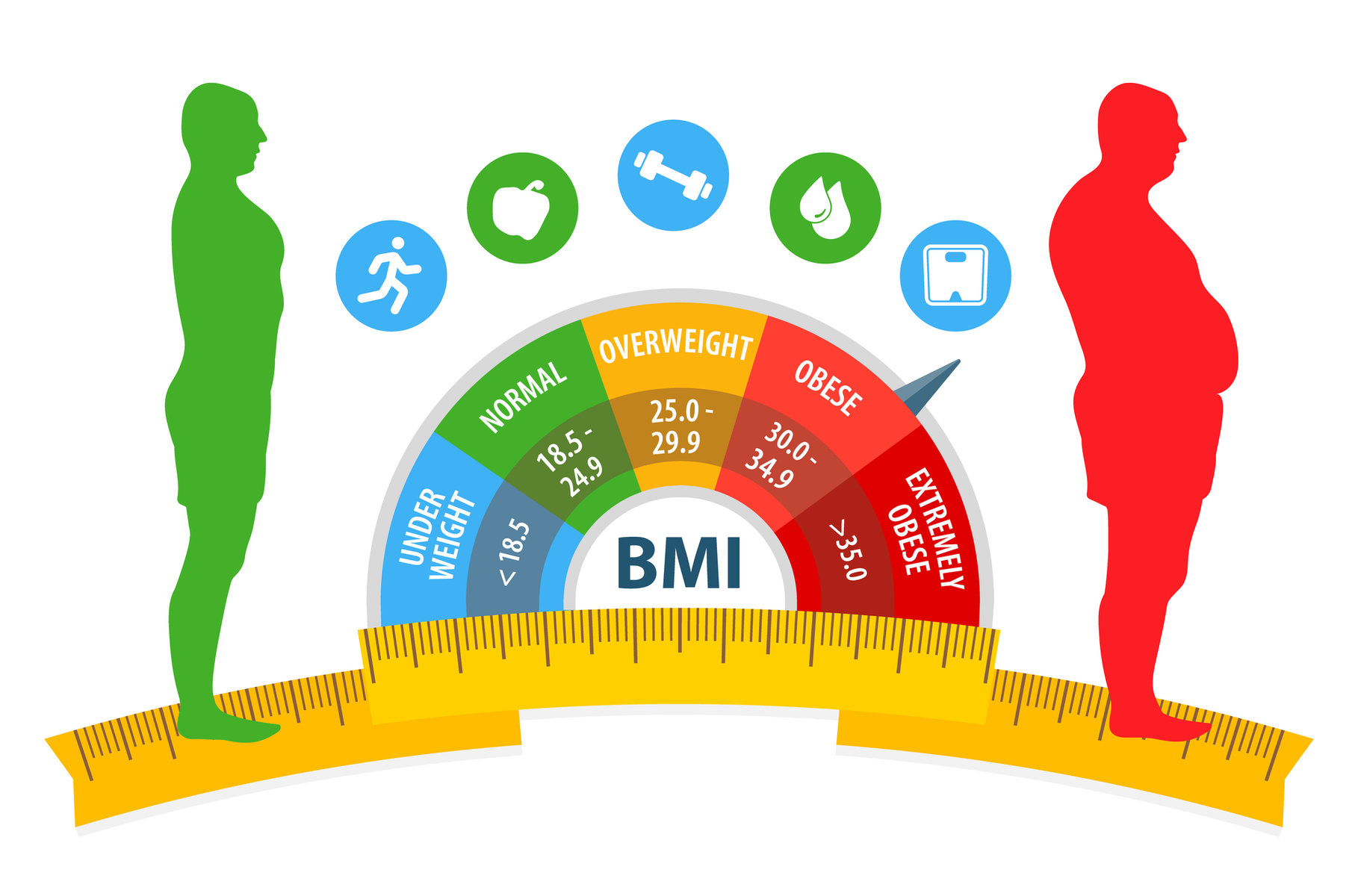
The Impact of Weight Fluctuations on Tummy Tuck Results
Maintaining a stable weight before and after undergoing abdominoplasty is key if you want those stellar surgical results to last long-term. Significant changes in weight, including pregnancy, can stretch skin and muscles tightened during the procedure, thus compromising its benefits over time.
Imagine gaining significant amounts after your operation due to dietary shifts or pregnancy; what happens? The newly repaired abdominal wall could potentially get stretched out again, thereby negating some initial gains achieved through this transformative process.
- Lifestyle modifications become crucial:
To prevent unwanted fluctuations post-tummy-tuck procedure, one must adopt lifestyle modifications, including regular exercise routines and balanced nutrition habits; essentially, living healthily becomes paramount if you want long-lasting satisfaction from having undergone abdominoplasty surgery.
Debunking Myths about Tummy Tucks
In the realm of cosmetic surgery, tummy tuck procedures are often misunderstood. One widespread myth is that a tummy tuck, known as abdominoplasty surgery, is an instant weight loss solution.
The truth? A tummy tuck isn’t designed for massive weight loss but rather to enhance body shape by eliminating loose skin and tightening stretched abdominal muscles after significant weight reduction or pregnancy. While maintaining a healthy lifestyle with regular exercise and a balanced diet plays a crucial role in overall health and preserving post-surgery results. However, they may not effectively address specific aesthetic concerns like excess fat or sagging skin.
Ideal Candidates for Tummy Tuck Surgery
An equally prevalent misconception revolves around who makes the perfect candidate for this type of plastic surgery. Contrary to popular belief that only women can benefit from this procedure, both genders can experience improved body contouring through a well-executed tummmy tucking operation.
Typically speaking, ideal candidates should be at their target healthy BMI (Body Mass Index), ensuring minimal future fluctuations which could compromise surgical outcomes if substantial weight gain occurs post-operation, stretching out tightened areas again.
Apart from being within their optimal BMI range, potential patients need realistic expectations regarding what improvements are possible aesthetically via such surgeries – something your surgeon will clarify during consultation based on individual circumstances.
Note: It’s always advisable to have thorough discussions with your Cosmetic Surgeon before deciding whether any form of cosmetic treatment aligns with personal health goals.

Nutrition’s Role in Enhancing Tummy Tuck Results
When maximizing the benefits of a tummy tuck procedure, nutrition is indispensable. A balanced diet not only aids recovery after abdominoplasty surgery but also helps maintain your body shape long-term.
The right nutrients can support wound healing and immune function while reducing inflammation. This is crucial for a smooth recovery process and enhanced surgical outcomes. Moreover, maintaining a healthy weight post-surgery through proper nutrition can help sustain the aesthetic benefits of your procedure.
Foods to Include in Your Diet
A nutrient-rich diet should be part of every patient’s lifestyle before and after undergoing tummy tuck surgery. Including nutrient-dense foods such as lean proteins and vitamin C-rich fruits in your diet can help promote healing during abdominoplasty recovery.
Lean proteins such as chicken breast or tofu aid tissue repair and muscle growth, which are essential during the abdominoplasty recovery period. Fruits like berries or oranges provide vital vitamin C necessary for boosting collagen production – a key element contributing towards skin elasticity & wound healing processes. Green leafy vegetables packed with iron play a significant role in red blood cell production, aiding oxygen supply throughout the human system during any major operation, including plastic surgeries like abdominoplasties.
Foods to Avoid Pre- and Post-Surgery
Certain food items might hinder your progress towards complete recovery following cosmetic procedures and contribute towards unwanted weight gain, thus impacting longevity achieved from these treatments adversely too. It’s therefore important to make conscious choices about what we consume pre- and post-operation times both.
Sugary drinks & snacks, processed meats, and refined grains all fall under the category termed ‘unhealthy’ food options, potentially leading one down a path filled with unnecessary calories, hence best avoided if you wish to enjoy prolonged positive effects from this type of body contouring treatment. Excessive alcohol consumption around the time frame when medical operations take place could delay normal healing mechanisms within our bodies so its recommended avoiding the same until full restoration of health has been accomplished.
Mayo Clinic offers detailed insights on why avoiding alcohol consumption during surgery benefits patients. By making informed decisions regarding dietary habits, we significantly enhance chances at enjoying extended periods of satisfaction following cosmetic treatments, ensuring overall happiness levels remain high over longer durations too.
Fitness’ Role in Sustaining Tummy Tuck Results
So, you’ve had your tummy tuck surgery and are thrilled with the results. But how do you ensure these fantastic changes stick around for good? The answer lies within a healthy lifestyle that includes regular exercise. Patience is essential to ensure that the results of a tummy tuck are maintained in the long term. Jumping back into strenuous workouts too soon could jeopardize those hard-earned tummy tuck results.
Recommended Exercises Post-Tummy Tuck Recovery
We all know walking longer distances can be beneficial after any surgical procedure – but why exactly is this so?
This simple activity lays an excellent foundation as you gradually build up toward more intensive exercises.
If swimming or cycling tickles your fancy once fully healed from surgery, go ahead and dive right in (pun intended.). These low-impact activities provide cardiovascular benefits without straining the abdominal muscles, perfect for maintaining body shape post-surgery.
Pilates and yoga might seem challenging at first glance but don’t let that deter you. They focus on core strength, which is essential to sustaining long-term abdominoplasty outcomes.
Exercise Precautions After Abdominoplasty Surgery
Achieving optimal fitness levels following a significant weight loss transformation, such as a tummy tuck, requires careful planning. Remember always to listen to your body during each workout session. If anything feels off or uncomfortable beyond typical muscle soreness associated with new routines, it’s time to take things easy.
Your Cosmetic Surgeon will guide you when heavy lifting or high-intensity workouts should resume, typically about six weeks post-op, depending on individual recovery progress.
Maintaining Long-Term Results After A Tummy Tuck
After a tummy tuck procedure, the journey to enhancing your appearance doesn’t stop. To maintain that new body shape and ensure long-lasting results from this transformative plastic surgery, you need to commit to a healthy lifestyle.
Avoiding Significant Weight Fluctuations
The first step towards maintaining those impressive abdominoplasty recovery outcomes is achieving and sustaining a healthy weight. Any rapid changes in your body mass index can lead to stretching of skin and abdominal muscles which could undermine the benefits of your surgery.
Rather than falling for quick fixes like fad diets that often result in rebound weight gain due their restrictive nature, opt for gradual changes aimed at promoting overall health (Mayo Clinic). This includes incorporating more whole foods into your diet while reducing processed ones as well as regular physical activity – both crucial elements when it comes avoiding unwanted post-surgery weight gain or significant loss after massive weight loss procedures.
This not only helps keep excess fat at bay but also tones up those newly tightened muscles ensuring optimal post-tummy tuck contouring effects over time.
Maintaining Regular Exercise Routines
Regular exercise plays an equally important role by helping tone & strengthen abdominal muscles further contributing towards maintaining desired surgical outcome. However, remember all exercises aren’t suitable immediately following abdominoplasty recovery; starting with walking longer distances might be a safe bet before gradually introducing strenuous activities such as strength training under professional guidance (National Institutes Health).
Paying Attention Nutrition
Nutrition is vital too. It supports tissue repair, immune function, among other processes essential to the healing process, thus influencing the longevity of results achieved through Moein Surgical Arts’ comprehensive approach to patient care. Incorporate nutrient-rich foods, lean proteins, muscle repair fruits, vegetables rich in vitamins C and E, and aid wound healing omega-3 fatty acids found in fish and nuts known for their anti-inflammatory properties, etc., into your daily meals. Meanwhile, avoid food items high in sugar and unhealthy fats that contribute to potential regain lost during the initial phase of losing excessive pounds prior to the operation MedlinePlus.
Scheduling Regular Check-ups With Your Cosmetic Surgeon
Your relationship with your surgeon doesn’t end once you leave the operating room; they’re there even after, making sure everything continues smoothly. These follow-up visits allow them to monitor progress and adjust any concerns if needed, protecting the longevity of the surgical outcome. If considering additional procedures like breast augmentation or liposuction, discuss the timeline and potential risks involved in appointments to ensure the safety and satisfaction of your aesthetic goals are achieved.
In essence, improving your appearance doesn’t just stop at a successful operation; it extends beyond, embracing a balanced diet, regular fitness routine, and careful monitoring by health professionals dedicated to serving your best interests every step of the way. The end objective isn’t only to appear attractive, but also to feel great.
FAQs in Relation to The Role of Fitness and Nutrition in Enhancing Tummy Tuck Results
How do you optimize tummy tuck results?
To optimize tummy tuck results, maintain a stable weight through balanced nutrition and regular exercise. Avoid significant weight fluctuations and adhere to your surgeon’s post-operative care instructions.
Can exercise help a tummy tuck?
Yes, incorporating low-impact exercises into your routine after recovery can help sustain the results of a tummy tuck by keeping off excess fat and toning abdominal muscles.
Does exercise reduce swelling after a tummy-tuck?
Mild forms of exercise like walking can aid in reducing post-surgery swelling. However, it’s crucial to wait for full recovery before resuming strenuous workouts.
Why is protein important after a tummy-tuck?
Dietary protein supports wound healing and immune function while reducing inflammation, making it vital for optimal recovery following abdominoplasty surgery.
Conclusion
When it comes to tummy tucks, your Body Mass Index matters.
Maintaining a stable weight is key for optimal results.
Remember, this procedure isn’t a magic solution for weight loss or just for women.
The Role of Fitness and Nutrition in Enhancing Tummy Tuck Results can’t be overstated.
A balanced diet rich in essential nutrients supports recovery and enhances surgical outcomes.
Certain foods might hinder healing or contribute to post-surgery weight gain – avoid them!
Fitness plays its part too by helping you keep off excess fat and tone your abdominal muscles after surgery.
But don’t rush back into strenuous workouts – give yourself time to recover fully first!
In the long run, sustaining your new physique requires commitment: Regular physical activity, eating nutritiously, and visiting your cosmetic surgeon regularly are all essential for sustaining the outcomes of a tummy tuck.
If you’re ready to transform your body through cosmetic surgery while embracing healthier lifestyle choices, Moein Surgical Arts is here to guide you every step of the way. Click here now let’s get started on enhancing those tummy tuck results together!
]]>When it comes to body contouring and achieving that desired shape, a hurdle is… making this decision. It can feel like standing at the crossroads of Tummy Tuck and Liposuction, unsure of which path will lead you to your dream silhouette. But here lies the difference between those who keep dreaming about their ideal body shape and those who take action toward achieving it.
Consider Jane – she lost significant weight but was left with sagging skin around her abdomen. She thought liposuction would be enough until she learned more about tummy tucks. The concern of making the wrong choice has her second-guessing her options now! Can you relate?
To make an informed decision on whether to go for a tummy tuck vs liposuction or both…you need all the facts.
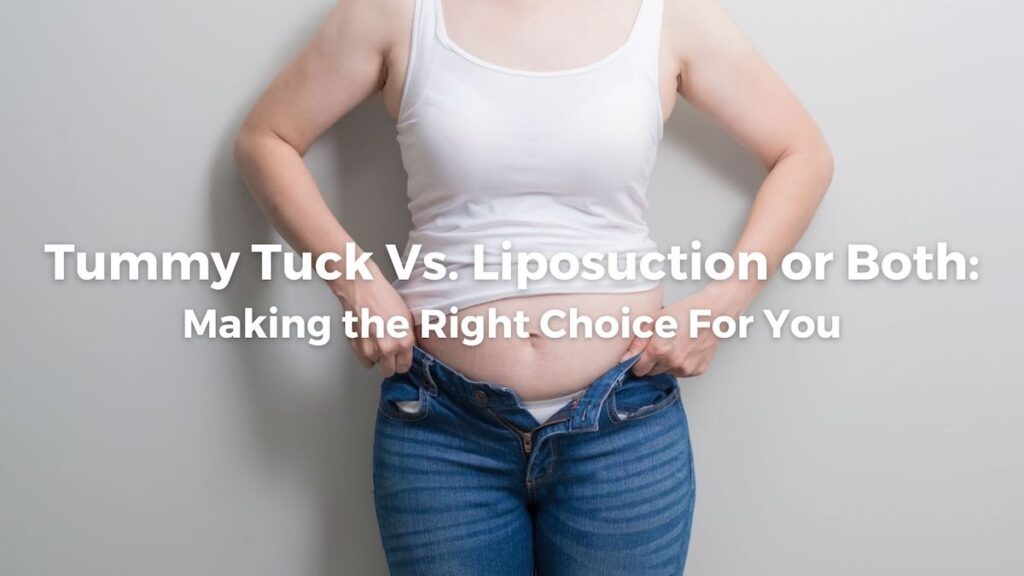
Tummy Tuck Vs Liposuction: An Overview
Ever wondered about the difference between Tummy Tuck vs Liposuction? Or perhaps you’re curious about which procedure might suit your unique body goals. In this world of cosmetic procedures, it’s essential to understand that while both these surgical interventions aim at enhancing one’s physical aesthetics, they serve distinct purposes.
Liposuction, commonly called lipo, targets stubborn pockets of fat deposits resistant to diet and exercise. It involves making small incisions through which a Cosmetic Surgeon uses suction techniques to remove unwanted fat cells from specific areas like love handles or the lower back. The primary goal here isn’t weight loss per se but rather reshaping the body by removing fatty tissue.
On the other hand, a debate on tummy tuck vs liposuction often arises when individuals seek fat removal, skin tightening, and muscle repair. A tummy tuck, or abdominoplasty, removes excess skin and tightens abdominal muscles, making it ideal for those who have experienced significant weight loss or pregnancy-related changes.
Understanding the differences between tummy tuck vs liposuction is crucial in choosing the correct procedure for your aesthetic goals. While liposuction is best for sculpting and contouring, a tummy tuck provides more comprehensive abdominal tightening and reshaping. Consulting with a qualified surgeon can help determine which procedure fits best with your desired results.
Tackling Excess Skin with Abdominoplasty
Moving to tummy tucks, medically known as abdominoplasty – we see an entirely different focus area. A mini tummy tuck surgery targets sagging skin and excess fat around the belly button towards the lower abdomen region. A full tummy tuck focuses on excessive skin, fat and often muscle plication above the waist.
A board-certified cosmetic or Cosmetic Surgeon makes a horizontal incision across this area and removes excess skin. In the case of a full tuck, they often tighten weakened abdominal muscles while also getting rid of any extra skin left behind after significant weight loss or pregnancy – offering patients a flatter-looking stomach. A full tuck may or may not require muscle repair, but it often does.
The Decision Factor Between Liposuctions and Tummy Tucks

So, what should be your choice between these two options? Much depends on individual needs and objectives discussed during consultation sessions with your chosen Cosmetic Surgeons.
Liposuction could be your go-to choice if localized pockets of stubborn fats bother you most, given its contouring results. If skin looseness is slight and your skin has good elasticity, non-surgical skin tightening may be an option.
On the other hand, if loose skin is more prevalent post substantial weight reduction, aging, or childbirth events, opting for a tummy-tuck would make better sense since it addresses excess fas and tackles saggy skin too. Note: skin with stretch marks has broken elasticity and does not snap back after liposuction.
We’ll delve deeper into each process involved, including recovery times required post-surgeries in subsequent sections so stay tuned.
The Surgical Procedures Explained
So, you’re considering a cosmetic procedure to enhance your appearance. What procedure should you choose? Let’s dive deeper into the specifics of two popular options: liposuction and tummy tucks.
The Liposuction Procedure
Liposuction has been a go-to choice for many looking to remove unwanted fat from stubborn areas like love handles or lower back. It all starts with small incisions made by an experienced board-certified Cosmetic Surgeon in targeted spots where those pesky fat deposits reside.
This relatively non-invasive procedure aims to reshape specific body parts by removing resistant pockets of excess fat that dieting or exercise can’t seem to touch or deposited in places determined by genetics that create a square vs. curvy shape. For more details about what happens during liposuction surgery, click here.
The Tummy Tuck Procedure
Depending on the type of tummy tuck (or abdominoplasty), it can go beyond just dealing with loose skin; it also tightens weakened abdominal muscles giving your midsection an overall firmer look. This process involves making a horizontal incision across your lower abdomen – its length depends on how much skin needs removal and how separated the muscle is. In the case of a mini tuck, designed to address skin below the navel, the incision tends to be shorter, but again, it is determined by how much skin needs to be removed and how long it has to be to ensure the scar is flat.
Your newly tightened muscle layer gets redraped with skin that has been trimmed, ensuring smoother contours for that flatter belly button area we all desire. Click here to learn more about typical steps during a full-fledged tummy-tuck session.
Comparing Costs Between Liposuction and Tummy Tucks
With cosmetic procedures, understanding financial commitment is crucial to your decision-making process. There is a disparity in average costs regarding Tummy Tuck Vs Liposuction surgery.
Liposuction – primarily designed for removing unwanted fat from targeted areas like love handles or lower back – averages in the LA area between 7K and 18K, depending on the procedure’s extent and if body sculpting is involved. Full 360 high-definition liposuction body sculpting would naturally cost more than liposuction for a few debulking areas. This figure can fluctuate based on several factors, such as:
- How much fatty tissue needs removal
- Where you’re having the procedure performed
- Whether you have traditional vs. VASER high-def lipo (body sculpting)
- If you have abdominal etching
- The demand for the surgeon
The Financial Implication Of A Tummy Tuck Procedure
At 8K to 20K for a complicated fleur-de-lis tuck done after massive weight loss, getting that flatter tummy via abdominoplasty costs significantly more than lipolysis alone (fat cell destruction). It depends if the procedure involves eliminating excess skin or tightening abdominal muscles, which makes it somewhat complex compared with simpler surgical operations aimed solely at eliminating fat deposits within body contours.
This surgical procedure requires general anesthesia and longer operating times due to both complexities involved in removing sagging skin from the lower abdomen while simultaneously tightening loose abdominal wall muscles through a horizontal incision made across the belly button region – hence justifying its higher price point relative to other simpler cosmetic procedures like lipo-surgical operations targeting localized adipose deposits specifically.
Getting further insights into why achieving desired results, such as tighter abs, might require a greater investment than regular lipo-surgical operations. Sometimes undergoing both procedures might be beneficial or necessary, especially when large amounts of unwanted fats must be removed, followed by addressing any resultant loose skin left behind after significant weight loss achieved either naturally or post-bariatric surgeries. As a rule, most surgeons will adjust the costs lower if both procedures are done in one surgery, saving time and expense in the operating room.
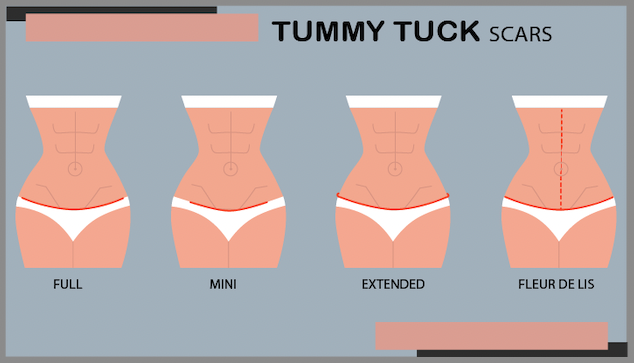
Ideal Candidates for Each Procedure
Deciding between a tummy tuck and liposuction for cosmetic purposes can be intimidating. The key lies in understanding who makes an ideal candidate for each procedure.
Liposuction: For Those Seeking Fat Removal
The primary goal of liposuction surgery isn’t necessarily weight loss but slimming specific areas of your body by removing excess fatty tissue. This might be your go-to solution if you have stubborn pockets of unwanted fat around love handles or lower back that refuse to budge despite diet and exercise efforts. It will give you a curvier you!
A crucial determinant here is skin elasticity; if you possess firm, elastic skin, chances are higher that post-surgery results will be more satisfactory as such type of dermis naturally conforms to new bodily contours following removal of fat cells. If minor skin redundancy is a concern, ask about non-surgical skin tightening with j-plasma technology.
Tummy Tuck: Beneficial for Loose Skin After Weight Loss or Pregnancy
If sagging abdominal muscles along the belly button area bother you due to drastic changes like massive weight reduction or childbirth, aging or stretch marked skin, then a tummy tucks procedure is necessary.
You will make perfect candidates if you have a stable weight yet deal with droopy midsections caused by aging factors, pregnancies or successful weight loss. Remember though – always keep expectations realistic about what these surgeries could accomplish; they should never replace healthy lifestyle habits.
In Consultation With Your Trusted Cosmetic Surgeon
No matter which treatment seems most appealing based on these criteria above, consulting expert advice remains paramount before making decisions regarding plastic surgery operations. Your surgeon will assess individual situations thoroughly, considering health status, medical history, and combined aesthetic goals for effective outcomes in personalized treatment plans.
Liposuction vs Tummy Tuck Results?
Diving into the world of cosmetic procedures can feel like navigating a labyrinth. However, when you break it down, understanding what to expect from liposuction and tummy tuck surgery is pretty straightforward.
Let’s recap the difference between the procedures.
Liposuction Results: The Skinny on Fat Removal
You’ve decided to undergo liposuction surgery. So how does this procedure transform your body? It zeroes in on stubborn fat deposits that refuse to budge despite dieting or exercise. Post-surgery, patients usually see an impressive reduction in these fatty areas resulting in improved overall body shape.
However, remember one important fact about liposuctions – while the removed fat cells don’t return, if there is significant weight gain post-surgery, fat in other parts of your body gets much bigger. Hence maintaining a stable weight through healthy lifestyle choices becomes crucial for preserving those sleek results long-term.
Tummy Tuck Results: Unveiling Your Flatter Abdomen
A tummy tuck procedure, also known as abdominoplasty, goes beyond just removing excess skin and unwanted fat; it tightens weakened abdominal muscles too.
- The result? A flatter abdomen with enhanced muscle tone makes your midsection more defined.
- In contrast with liposuction, where future weight gains could potentially impact results negatively, once fully healed after undergoing a tummy-tuck, barring massive fluctuations due to pregnancy or excessive weigh-gain, your newly tightened abdominal wall should remain relatively unchanged over time thanks largely part underlying muscular support structure now place prevent potential sagging issues arising later line. That is not to say that visceral fat gained would not push the muscles forward.
- This invasive surgical procedure offers greater permanence compared to its less-invasive counterpart.
Potential Complications & Risks
Every surgical operation, including liposuction and tummy tucks, may have its possible issues and dangers. It’s crucial to understand these before you decide which cosmetic procedure is the right choice for your body.
Liposuction Risks
Liposuction surgery offers an effective solution in a world where everyone wants quick fixes to get rid of unwanted fat deposits in areas like love handles or lower back. However, it does come with certain risks, such:
- Infection
- Scarring
- Fat embolism – loosened fat enters the bloodstream causing blockages
A study on PubMed also highlights that patients may experience temporary swelling or numbness post-surgery along with bruising at incision sites used during this invasive procedure.
Tummy Tuck Risks
If loose skin around your abdominal area bothers you more than small pockets of excess fat, then a tummy tuck might be what you need instead. But remember: This isn’t just about removing sagging skin from the lower abdomen region but also tightening up those lax abdominal muscles through horizontal incisions across the belly button level (or slightly below). And while results can indeed give flatter tummies, additional risk factors are also associated here.
The American Acadamy of Cosmetic Surgery has identified several possible issues arising out postoperative period following abdominoplasty procedures. These include poor wound healing leading to visible scars around the navel area. Also, changes in sensation due to nerve damage operation could occur over time. So make sure to discuss all these points in detail board-certified cosmetic surgeon planning phase itself so that there are no surprises later down the line.
Making Informed Decisions With Your Board-Certified Cosmetic Surgeon
To ensure safety throughout the entire process, starting pre-operative consultations until the recovery period following the actual surgical intervention itself, working closely with board-certified Cosmetic Surgeons who specialize in types of surgeries becomes essential to achieving desired physical improvements effectively and safely without compromising the health and well-being of patients overall.
When Combining Both Procedures Makes Sense
Combining cosmetic procedures to achieve optimal results can be advantageous rather than simply choosing between the two. Sometimes, combining treatments can be beneficial to achieve optimal results and meet patient expectations.
The concept here is simple: use each procedure where they shine most – Liposuction removes unwanted fat deposits, while a Tummy Tuck tightens sagging skin and strengthens weakened abdominal muscles.
Liposuction & Tummy Tucks: A Powerful Duo?
If you’ve been grappling with stubborn fatty tissue in areas like your love handles, belly, bra area, or lower back that diet and exercise won’t shift, then liposuction surgery could be your answer. However, if lipo leaves behind loose skin, that will require further attention.
Selecting Your Procedure(s): An Informed Decision Is Key.
Whether one should opt for both procedures depends largely on personal goals and professional advice from their chosen board-certified cosmetic surgeon.
FAQs in Relation to Tummy Tuck Vs Liposuction or Both
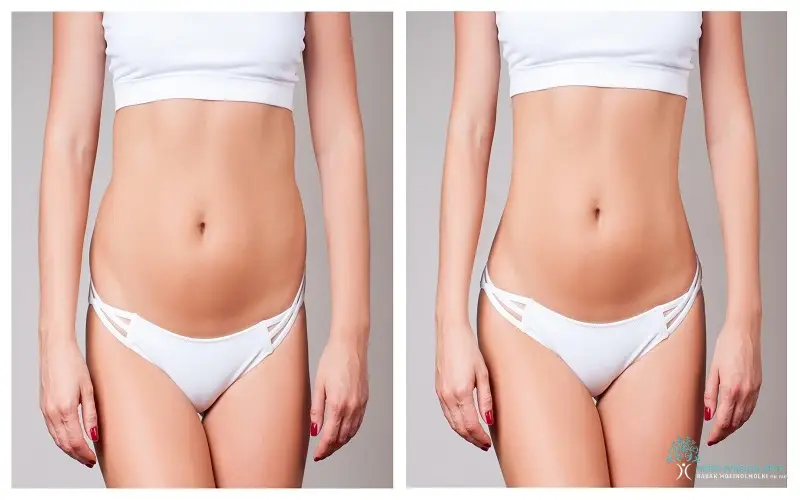
Should I get liposuction or a tummy tuck?
Your choice between liposuction and a tummy tuck depends on your specific goals. Liposuction is ideal for removing small fat deposits, while a tummy tuck addresses loose skin and strengthens the abdominal wall.
What removes more fat: a tummy tuck or liposuction?
Liposuction specifically targets larger fat removal volumes than a traditional Tummy Tuck. However, combining both procedures can optimize results when dealing with substantial unwanted fat, muscle separation and sagging skin.
What is better than a tummy tuck?
No procedure is universally “better” than another; it depends on individual needs. For instance, if you have good skin elasticity but struggle with stubborn belly fat, then liposuction might be more suitable for you than a Tummy Tuck.
What is the best surgery for belly fat?
The best surgical option for belly fat largely depends on your personal circumstances. Liposuction effectively removes localized pockets of excess adipose tissue, whereas abdominoplasty (tummy tuck) is optimal when addressing excessive loose abdominal skin.
Final Thoughts: Tummy Tuck
vs Liposuction
Embarking on the body contouring journey can feel like standing at a crossroads. Tummy tuck or liposuction, which path will lead you to your dream silhouette? You’ve learned that these procedures aren’t interchangeable.
- The surgical process differs, too—small incisions for liposuction contrast with the more invasive horizontal cut required for a tummy tuck.
- Recovery times vary – seven to fourteen days post-liposuction versus three to four weeks following a tummy tuck.
- Costs differ significantly between these procedures
- The ideal candidate profile can differ
- Both surgeries offer lasting changes, but weight gain could affect outcomes differently after each procedure
- Your results expectations should be based on being fully informed so that you know what to expect
- Potential complications exist with any surgery so being aware is critical in making an informed decision.
Sometimes combining both procedures makes sense if you want to remove large amounts of unwanted fat and tighten loose skin left behind.
Deciding between tummy tuck vs liposuction or considering both? It’s all about what’s right for YOU!
What’s Next?
If this feels overwhelming, don’t worry! At Moein Surgical Arts, we specialize in cosmetic surgery and are here to guide you toward achieving your desired shape safely and effectively. Ready to take action? Please schedule a consultation, call 310-455-8020 seven days a week from 8 am to 8 pm, or fill out our contact form here.
For more information on what to expect after liposuction, read our blog Liposuction After Four Weeks – What To Expect.
]]>Tummy tuck surgery is a popular procedure among clients seeking to improve the appearance of their abdomen. It involves removing excess fat and redundant skin and tightening muscles in the abdominal wall that may have loosened. The recovery time following this type of surgery can be lengthy, and patients need to understand what steps to be taken during their recovery to ensure successful healing. One such question many individuals have is whether they require a garment after tummy tuck surgery. This article will discuss the importance of wearing a garment post-surgery and how long it should be worn for optimal results.
The goal of any surgical procedure is to achieve the desired outcome with minimal complications; this also applies to abdominoplasty (tummy tuck) surgery. During a tummy tuck, tissue must be manipulated to alter your stomach shape and contour; therefore, proper measures must be taken throughout the patient’s recovery period to prevent unnecessary tissue irritation or damage. Wearing a specific piece of clothing known as a compression garment has been shown to reduce swelling, help support newly repaired, tightened muscles, and provide overall comfort while healing from tummy tuck surgery.
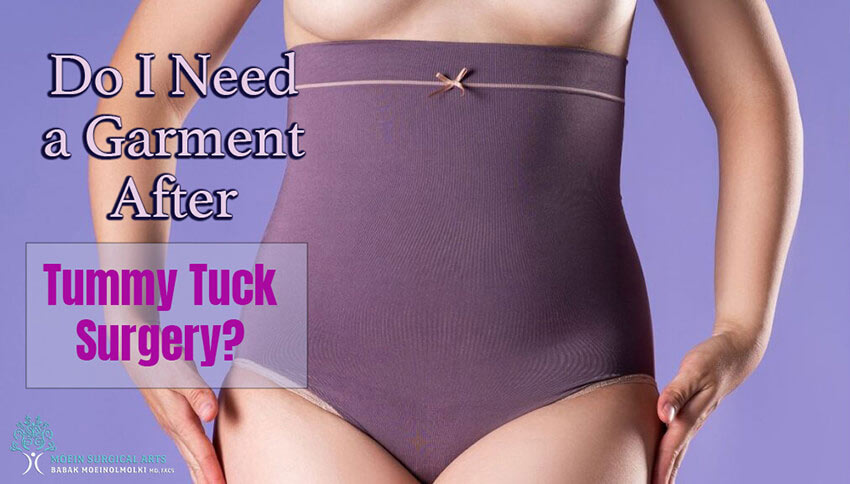
It can intimidate for someone considering abdominoplasty surgery when there are so many unknowns about their surgical journey; however, understanding why wearing a compression garment is beneficial and knowing how long it needs to be worn after tummy tuck procedures can provide assurance and help ease any anxiety regarding transition into life post-surgery. For this reason, we aim to answer some common questions regarding garments and offer advice on which types may work best depending on individual circumstances.
Overview Of Tummy Tuck Surgery
Tummy tuck surgery is a major surgical procedure intended to reshape the abdomen by removing excess fat and redundant skin and tightening the abdominal muscles. It has become increasingly popular over the years because of its ability to give people a tighter, more attractive stomach area. For those who have had significant weight loss or pregnancy-related changes in their body shape, it can be an excellent way to reclaim their pre-baby figure. Despite the transformation being possible through tummy tucks, many patients may question whether they require any garment after this operation.
It is important for those considering undergoing a tummy tuck to have realistic expectations. The surgery does not guarantee perfect abs; it aims to improve one’s appearance by reducing sagging skin and strengthening the core muscles. However, there will swell and bruising that should subside gradually with time. Wearing a compression garment is almost always recommended to help reduce swelling and speed healing. The garment will also provide additional support during activities such as walking or standing for extended periods, which helps prevent further discomfort or strain on the incision site. While undergoing a tummy tuck offers significant benefits, taking measures afterward, like wearing a proper compression garment, is essential for the best results.
Preparation For Tummy Tuck Surgery
Before undergoing tummy tuck surgery, patients must understand the preparation. During a pre-operative appointment with their surgeon, they should discuss expectations and ask questions about what will be needed from them before and after the surgery.
Patients must adhere to specific instructions regarding diet and activity levels to ensure successful outcomes. It is advised that they stop smoking, avoid using nicotine products for at least one month before their scheduled procedure, and adjust their medications if their healthcare provider recommends them. They also need to arrange transportation home following the surgery since sedation or anesthesia may be used during the operation and ensure someone stays with them for 24 hours afterward. Patients are asked to purchase loose-fitting clothing that can accommodate bandages, drains, or other equipment post-operatively; this measure would help reduce discomfort while healing occurs. Those with previous surgical procedures, such as liposuction or gastric bypass, should inform their doctor before scheduling an appointment for a tummy tuck so proper treatment plans can be established.
It is essential for individuals considering a tummy tuck procedure to know these details beforehand to plan for a safe recovery period afterward properly. Being prepared ahead of time in both mind and body can lead to better results from the procedure itself.
Benefits Of Wearing A Garment After Tummy Tuck Surgery

Wearing a garment post-surgery can benefit those undergoing a tummy tuck procedure. As an age-old adage states, “Prevention is better than cure,” which involves caring for your body after surgery. Wearing a garment helps keep swelling and discomfort at bay, thus enabling you to recover faster. It supports sutures and promotes skin retraction, which aids in creating more desirable results.
Garments are also effective in reducing or eliminating any drainage from incisions and helping to compress fat deposits located around the area where liposuction was performed. All these effects work together to reduce complications associated with healing, such as infection, poor wound closure, and slow recovery time. Ultimately, wearing a garment following your tummy tuck operation ensures you get the best possible outcome from your surgery.
Types Of Garments Available
After a tummy tuck surgery, wearing a specialized garment is recommended. These garments provide support and compression to the surgical area as it heals. Depending on the type of procedure performed, patients may be advised to wear these garments for up to 8 weeks post-operatively to optimize outcomes.
There are several types of garments available. Compression binders are recommended for liposuction procedures aimed at slimming or contouring the midsection, while larger abdominal binder wraps can help with more extensive surgeries like abdominoplasty. Girdles and shapewear may be prescribed after bariatric surgeries, such as gastric bypass or sleeve gastrectomy. Patients must select the size of their garment according to their physician’s recommendation to ensure optimal results from recovery.
When To Start Wearing A Garment
The healing process following a tummy tuck is arduous; however, the result can be life-altering. While you may feel ready to venture out into the world and show off your new physique, it’s important to remember that proper postoperative care must come first. A garment will help promote faster recovery by supporting incisions and aiding skin contraction. It’s recommended to wear a compression garment immediately after surgery and continue wearing it as long as directed by your physician.
Your doctor or nurse will provide specific instructions regarding when to wear the garment and how often to change it. Usually, patients should use the garment 24 hours per day during the initial weeks of recovery while gradually reducing the time spent in the garment. However, each individual’s timeline may vary depending on their procedure type and personal healing rate. Follow your surgeon’s orders closely to achieve optimal results with minimal complications.
How Long To Wear The Garment
Following a tummy tuck, the compression garment should be worn for at least six weeks. This is necessary to ensure proper healing and help decrease swelling. The garment should fit snugly but not constrict movement or cause pain. It’s important to follow your doctor’s instructions on how long you’ll need to wear it and ensure that any changes in size or shape are addressed as soon as possible.
The time required to wear the garment will vary depending on factors such as the type of procedure performed, individual anatomy, lifestyle activities, and other medical conditions. Based on these factors, your doctor can provide more detailed guidance about when to stop wearing the garment. There may be specific instructions for removing the garment to prevent further irritation or discomfort. Following these guidelines carefully will guarantee optimal results from your surgery with minimal risk of complications.
How Tight Should The Garment Fit?
Yes, you will need a garment after tummy tuck surgery. Your surgeon will probably recommend that you wear the garment 24 hours per day for at least six weeks post-operation. The garment supports and helps with healing, reduces swelling, and minimizes any discomfort or pain associated with your procedure. Many garments are available in today’s fashion world, so feel free!
The fit of the garment should be snug but not overly tight — think Goldilocks here: “just right.” You want it to feel comfortable and secure without being too restrictive. It should also cover your entire abdominal area from just below your chest to your pubic bone. If you have difficulty breathing or adjust it often, it may be too tight; if it shifts around on its own, it might be too loose. Consult with your physician if you’re unsure about the proper size before purchasing.
Tips For Comfort And Care
In the weeks following a tummy tuck, taking precautions for optimal comfort and care is important. First, wearing an appropriate garment can help reduce swelling and discomfort and improve your overall body contour after surgery. Your surgeon will provide specific instructions on which type of garment should be worn; this involves an abdominal binder or compression garment that must fit snugly against the skin without being too tight or restrictive. This support should remain in place during waking hours and be removed at night while lying down.
It is also important to keep up with any medications your doctor prescribes, including antibiotics, pain medication, and non-steroidal anti-inflammatory drugs (NSAIDs). Follow any activity recommendations issued by your doctor, such as light walking, when possible. If you experience serious side effects from these medications, contact your physician immediately. In addition, avoid lifting heavy items or engaging in strenuous activities until cleared by your doctor. Following these guidelines will ensure proper healing post-surgery and enable you to achieve desired results more quickly.
Alternatives To Wearing A Garment Post-Surgery
The decision to wear a garment post-surgery is like putting the final touches on an art project; it’s not always necessary but can provide benefits in certain circumstances. Some alternatives may be just as effective and more comfortable than wearing a constricting garment.
Doctors often recommend massaging the area gently with lotion or oil daily to help increase circulation and reduce discomfort. We should only do this after consulting your doctor and receiving an approval first. Short walks throughout the day can aid healing and prevent scarring or other issues from developing because of inactivity. Regularly performing deep breathing exercises also improves oxygen flow around the surgical site so that it heals properly without becoming inflamed. Finally, compression garments such as sports bras are recommended during exercise—especially high-impact activities—to ensure proper support of abdominal muscles and keep them from straining too much during movement.
Overall, if you choose not to wear a compressing garment post-surgery, these alternative methods will help ensure proper recovery while keeping you comfortable. Doing these things together results in faster healing times with fewer complications.
Potential Risks Associated With Not Wearing A Garment
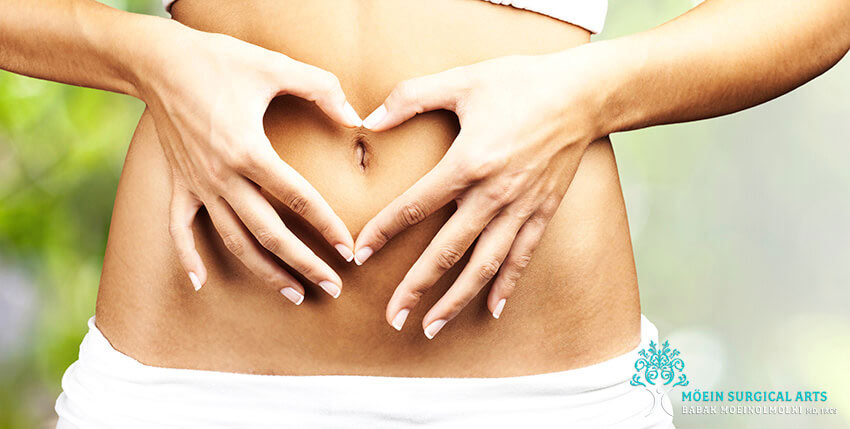
It is essential for individuals who have undergone tummy tuck surgery to wear a garment post-operatively. Not wearing the recommended garments can lead to medical complications and unsatisfactory surgical outcomes. The purpose of wearing a garment is threefold: (1) support, (2) compression, and (3) protection.
Support helps maintain the newly created contours of the abdomen while allowing skin retraction. Compression helps reduce swelling and limit fluid accumulation in the abdominal area. This helps minimize pain levels associated with the procedure. The protection ensures that clothing does not agitate incisions during recovery time. Therefore, failure to use appropriate postsurgical garments can lead to dehiscence, seroma formation, infection, wound separation/delayed healing, scarring, asymmetry, and excessive bleeding/bruising. All these potential risks may cause repeat surgeries for correction at additional costs, which could have been avoided through proper aftercare measures, including wearing prescribed garments as advised by your surgeon.
To achieve optimal results from abdominoplasty surgery, it is important to follow all instructions provided post-operatively; one such instruction is the regular use of a garment following this type of cosmetic surgery.
Garments After Tummy Tuck Surgery – Conclusion
It is important to note that wearing a garment post-tummy tuck surgery is not mandatory. However, it can provide many benefits. For those considering this procedure, doing adequate research and being aware of the potential risks associated with wearing and not wearing a garment after surgery may help make an informed decision about what is best for their individual needs.
There are alternatives, such as compression shorts or bands, that can be used instead of traditional garments. While anecdotal evidence suggests these options may support patients following tummy tuck surgery, more research is needed on this theory before any definitive conclusions can be made regarding its efficacy.
Overall, while wearing a garment post-tummy tuck surgery has several advantages, each patient must consider their personal preferences and lifestyle when deciding whether to use one. Taking all factors into consideration before having the procedure done will ensure that individuals receive optimal results from their experience.
]]>This post will explore how your life can change by adding tummy tuck and liposuction to your life. After undergoing both procedures, you can gain a slimmer midsection and an immense boost to your quality of life.
Keep reading to learn more about both cosmetic surgeries. You will learn how they are performed, the variations of procedures offered, and how much you stand to spend. If you have a flabby midsection, you’ll definitely want to read till the end.
Are You a Candidate for a Tummy Tuck?
Tummy tuck surgery (abdominoplasty) is a popular cosmetic procedure that is aimed at removing excess skin and fat from around the abdomen. In the hands of a talented cosmetic surgeon, the aesthetic technique can correct loose and saggy skin from the abdomen. This excess tissue may be present because of aging, genetics, significant weight gain or loss, and pregnancy.
The results of tummy tuck surgery are long-lasting and offer immense self-esteem benefits as well as skin quality enhancement.
You would be an excellent candidate for abdominoplasty if you have loose skin around your abdomen and are in good general health (including being a non-smoker). You should also be close to your ideal weight. For women interested in the procedure, you would be an ideal candidate if you aren’t planning any future pregnancies.
How is a Tummy Tuck Performed?

There are two types of a tummy tuck: the full and mini tummy tuck, depending on your body shape goals.
Full Tummy Tuck
The full tummy tuck is ideal for those with a rounded belly and/or excess skin folds above and below the navel. The aim of a full tummy tuck is to address the full length of the abdominal wall.
During the procedure, the cosmetic surgeon makes a horizontal or U-shaped incision above the pubic mound from hip to hip. The excess tissue is cut away before the remaining skin, tissue, and muscle are contoured as needed. The surgeon can even alter the shape and position of the belly button before the wounds are sutured closed.
Mini Tummy Tuck
A mini abdominoplasty is aimed at those with fat deposits located below the navel. During this procedure, the cosmetic surgeon creates a similar incision as the full tummy tuck. However, he will leave the cut a couple of inches long. Unlike the full abdominoplasty, the surgeon leaves the belly button alone. Because the incision is kept small, there tends to be less scarring with this abdominoplasty type.
During both a full and mini tummy tuck, the abdominal muscles are strengthened in addition to making the skin contoured and tight.
The mini tummy tuck is performed less often than the traditional tummy tuck. The mini may be recommended when there is only a small amount of excess skin and fat located below the belly button. When skin and fat hang noticeably from the abdomen, a full tummy tuck should be considered.
How Does Liposuction Enhance the Tummy Tuck?
Liposuction is a body contouring cosmetic surgery that uses suction to remove isolated pockets of fat that do not readily respond to diet and exercise. By itself, liposuction (or simply lipo) can rid the body of love handles, belly fat, and back rolls. The treatment does not address excess skin or muscle laxity following massive weight loss or pregnancy. A tummy tuck solves these problems when combined with the liposuction procedure.
Read our article: Where Can Liposuction Permanent Fat Removal Be Used on the Body?
When you combine the tummy tuck and liposuction procedures, you get a tighter abdomen. You will also get stronger abdominal muscles and a slimming effect via the removal of exercise-resistant fat. You also get the benefits of two surgeries during a single surgical session, necessitating the need for only one recovery period.
There is another benefit of the two cosmetic surgeries. Sometimes during a tummy tuck, surgical drains are inserted under the skin to collect drainage. The drainage tubes are removed during a follow-up appointment with your cosmetic surgeon.
When you opt for the tummy tuck and liposuction combo, the cosmetic surgeon can eliminate the need for post-surgical drains. He will do that by using a technique known as layered suturing. With this approach, you no longer need to mess with drainage tubes during recovery. The recovery is usually shorter than that of a regular tummy tuck as well.
How Is a Tummy Tuck and Liposuction Combination Performed?

The cosmetic surgeon performs liposuction after the incision has been made for the tummy tuck, and after the excess skin has been removed. During the lipo procedure, a hollow tube known as a cannula is used to break up and suction out fat cells. The technique is repeated often enough to allow the surgeon to remove the needed fat and contour the belly area. The contouring can extend to the hips, flanks, waist, and even the back for a maximum slimming effect. The end result is an improved overall body contour and streamlined silhouette.
Tummy Tuck and Traditional Liposuction VS HD Lipo
The tummy tuck is often paired with traditional liposuction which uses the cannula to manually break up stubborn pockets of fat. Your cosmetic surgeon may recommend HD lipo instead, which is useful for creating more definition around the treatment area.
Read our article: Liposuction Vs. HD-Lipo: What’s the Difference?
HD lipo is also known as high-def liposuction or VASER liposuction. With this advanced fat extraction technique, the cosmetic surgeon can sculpt an improved physique with results that look natural. The HD lipo technique not only minimizes unwanted fat but also creates more muscle definition.
During the procedure, the surgeon injects a tumescent solution into the abdominal area. The cannula is then inserted through a tiny incision. The VASER technology delivers powerful yet safe ultrasonic energy that liquefies and dislodges fat cells. The HD liposuction procedure is gentle enough to avoid damaging surrounding tissues. It is easily paired with the tummy tuck technique.
If your goal is a slimmer midsection with greater precision and enhanced definition between your abdominal muscles, the tummy tuck, and HD liposuction combination may be right for you.
The benefits of opting for HD lipo as opposed to traditional liposuction, aside from a more precise definition, include less swelling and a shorter recovery period.
How Much Does a Tummy Tuck and Lipo Combo Cost and is Insurance Any Help?
The average cost of a tummy tuck is $6,154, according to the American Society of Cosmetic Surgeons. The mini tummy tuck ranges from $3,500 to $8,000. Liposuction has an average cost of $3,637. Keep in mind that these fees do not cover associated costs like anesthesia. By combining the two procedures, you can save money on those added fees because you will only be paying for them a single time.
With regards to insurance, unfortunately, medical insurance typically only covers procedures that are medically necessary. That means your provider is unlikely to provide coverage since the tummy tuck and liposuction combination are aesthetic procedures by nature.
You should ask your cosmetic surgeon if they partner with a medical finance company like Care Credit or Prosper Healthcare Lending. These companies offer low-interest rates and long-term payment options. This will give you the ability to have surgery now while worrying about payment fulfillment later.
How to Prepare for a Tummy Tuck and Liposuction Operation
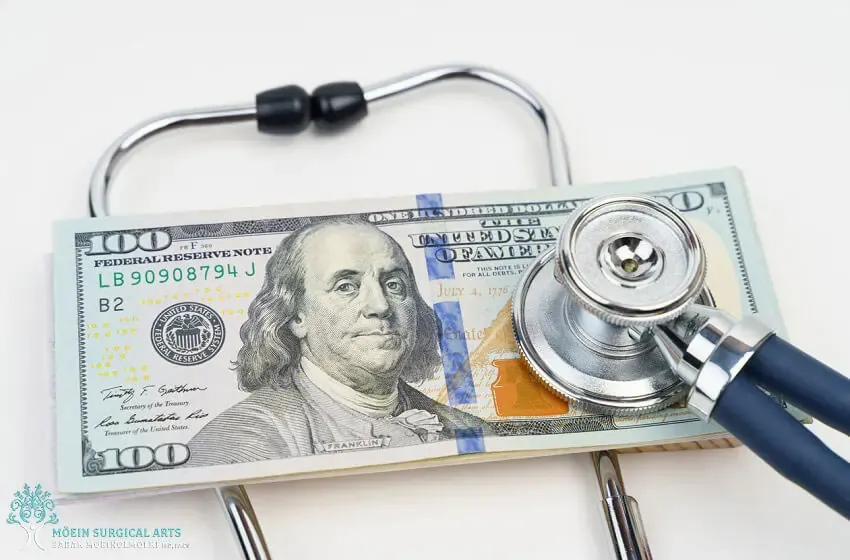
By now you are familiar with the goals of the tummy tuck and how the procedure is performed. You know that it pairs well with liposuction (and HD lipo) and how those procedures compliment the tummy tuck nicely. You are also more aware of the tighter abdomen and improved musculature you can receive by opting for both cosmetic procedures.
The first step to undergoing these cosmetic techniques is to schedule a consultation with a talented cosmetic surgeon. During your discreet meeting with the professional of your choice, you can feel free to discuss your insecurities and the specifics of the tummy tuck and liposuction combination procedure.
To ensure you are a suitable candidate for the procedure, the surgeon will ask about your medical history and health status before performing a physical examination. Here is where the skin and fat on your abdominal region will be thoroughly examined to determine if the tummy tuck and lipo can improve your physique and self-esteem.
Consultation
The consultation is also your chance to ask plenty of questions. You should ask to see before and after photographs. This can ensure that you will have realistic expectations for the results the cosmetic surgeon can deliver. You should inquire about the risks of the procedure, scarring and how the scars will look, and other considerations like fees, associated costs, and medical financing.
If you are deemed to be a suitable candidate for the tummy tuck and liposuction combination procedure, the surgeon will make sure you are well aware of how the procedure is performed. You may find the surgeon going into even greater detail than this article, as techniques sometimes vary from one professional to another.
The surgeon will also explain the recovery process. Since general anesthesia is used to ensure your comfort during the tummy tuck/lipo combo, you will want to have someone accompany you to the surgical center. That person can be your ride home and watch over you for a short while after you have returned home.
The surgeon will describe wound care and other recovery considerations. He will also how to prepare your home during the healing process. This includes making use of a body pillow, potentially a recliner, and having supplies on hands such as stool softeners, alcohol wipes, compression socks, scar care ointment, a toilet seat riser, and healthy, nutritious food items.
By the end of your appointment, you will be well aware of what to expect. You should be excited to achieve a new and improved physique through the use of advanced cosmetic surgery.
Read our article: When Can You Resume Exercise After a Tummy Tuck? (It’s Sooner Than You Think)
Ready to Improve Your Quality of Life? Schedule a Tummy Tuck + Lipo Consultation
Are you ready to sport a flatter, smoother, and tighter abdominal area? You can have the midsection you have always dreamed about by choosing a cosmetic surgeon experienced in the ways of the tummy tuck and liposuction combination. If you reside in Southern California, you are encouraged to call Moein Surgical Arts. We are the home of renowned cosmetic surgeon Doctor Babak Moein.
Doctor Moein offers a wide range of cosmetic surgery and non-surgical procedures at our accredited surgical center located in the heart of Los Angeles. By working with Doctor Moein, you have the benefit of working with a talented cosmetic surgeon and opting for a procedure that offers one of the highest degrees of satisfaction out of any other cosmetic surgery procedure.
Book your consultation with Doctor Moein by dialing (310)597-4976.
]]>